Spanish-style landscaping channels the rustic charm and sun-drenched beauty of the Mediterranean, creating a front yard that feels both elegant and inviting. This design aesthetic is defined by its use of natural materials, earthy color palettes, and a harmonious blend of structured layouts and lush, drought-tolerant plantings. Key elements like stucco walls, terracotta pots, wrought iron, and vibrant tilework come together to craft an outdoor space that is visually striking and deeply connected to its architectural roots. Embracing this style transforms your home's entrance into a warm, welcoming retreat that evokes a timeless sense of place.
1. Stucco Wall Courtyard Enclosure
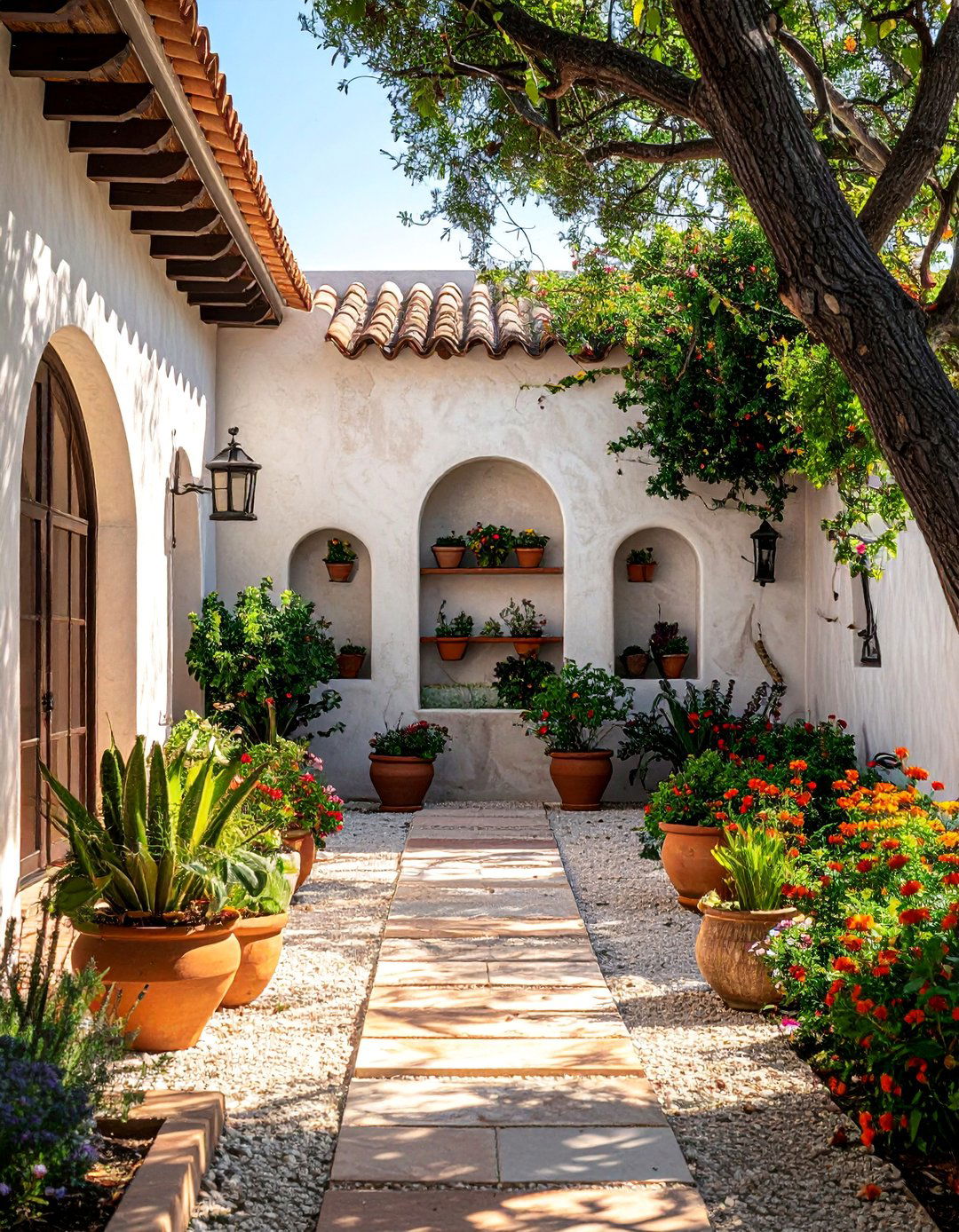
A defining feature of Spanish landscaping is the creation of intimate, enclosed spaces. A low stucco wall, finished in a warm white or earthy ochre, establishes a private front courtyard that separates your home from the street. This structure provides a sense of sanctuary and serves as a perfect backdrop for other design elements. The smooth, textured surface of the stucco contrasts beautifully with lush greenery and the dark accents of wrought iron gates or wooden doors. Consider incorporating built-in benches or small niches within the wall to hold decorative pots or lanterns, further enhancing the authentic, integrated feel of the space.
2. Terracotta Potted Plant Arrangements
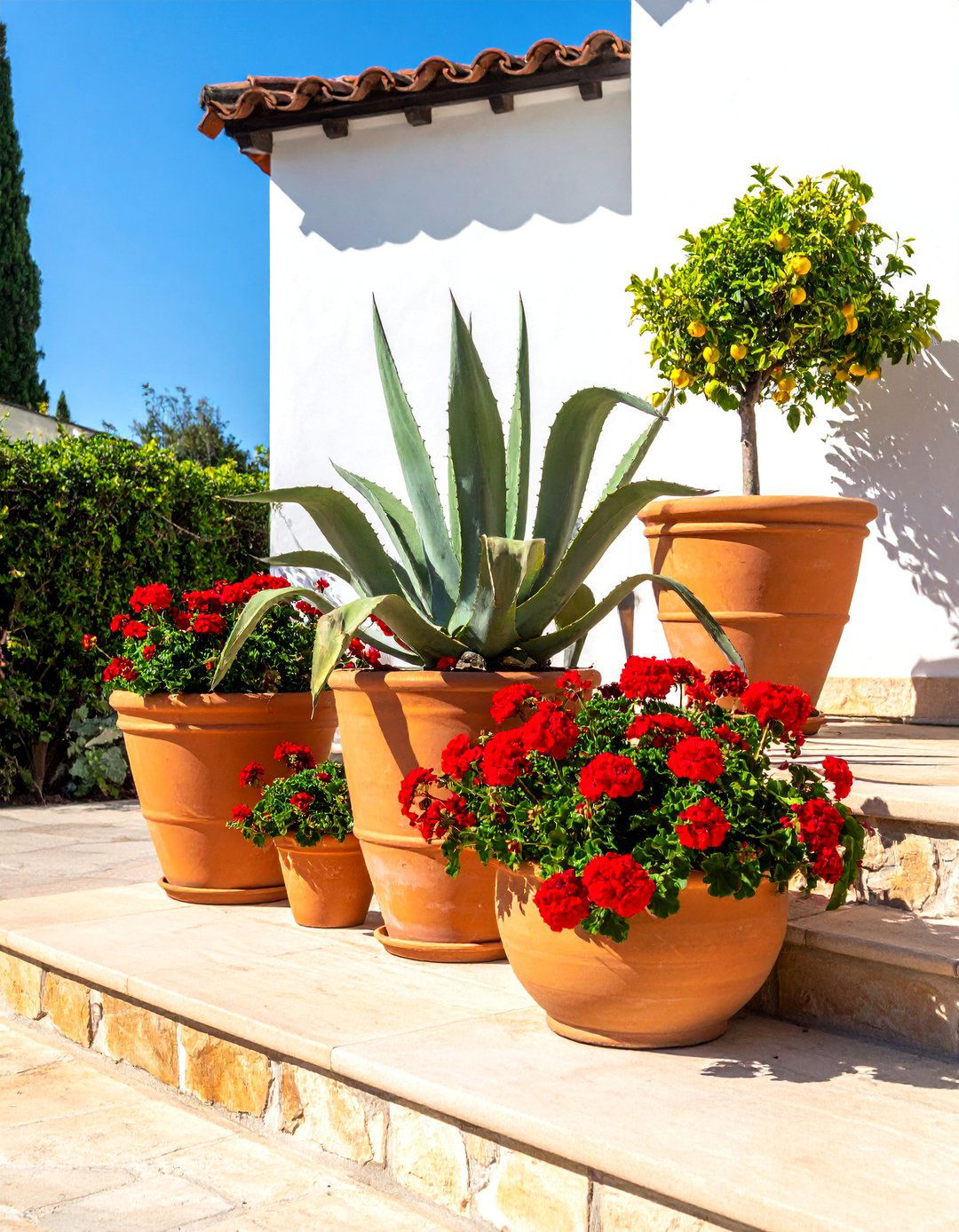
Terracotta pots are an indispensable element in any Spanish-style front yard. Grouping various sizes of these classic earthenware containers creates visual interest and layered texture. Arrange them along pathways, on steps leading to the entrance, or as a focal point in a gravel bed. Plant them with a mix of vibrant geraniums, sculptural agaves, fragrant rosemary, and even small citrus or olive trees. The warm, reddish-brown hue of the terracotta complements the green foliage and colorful blooms, embodying the rustic and earthy palette central to this design style. This approach offers flexibility and allows you to easily update your garden's look.
3. Wrought Iron Gates and Fencing
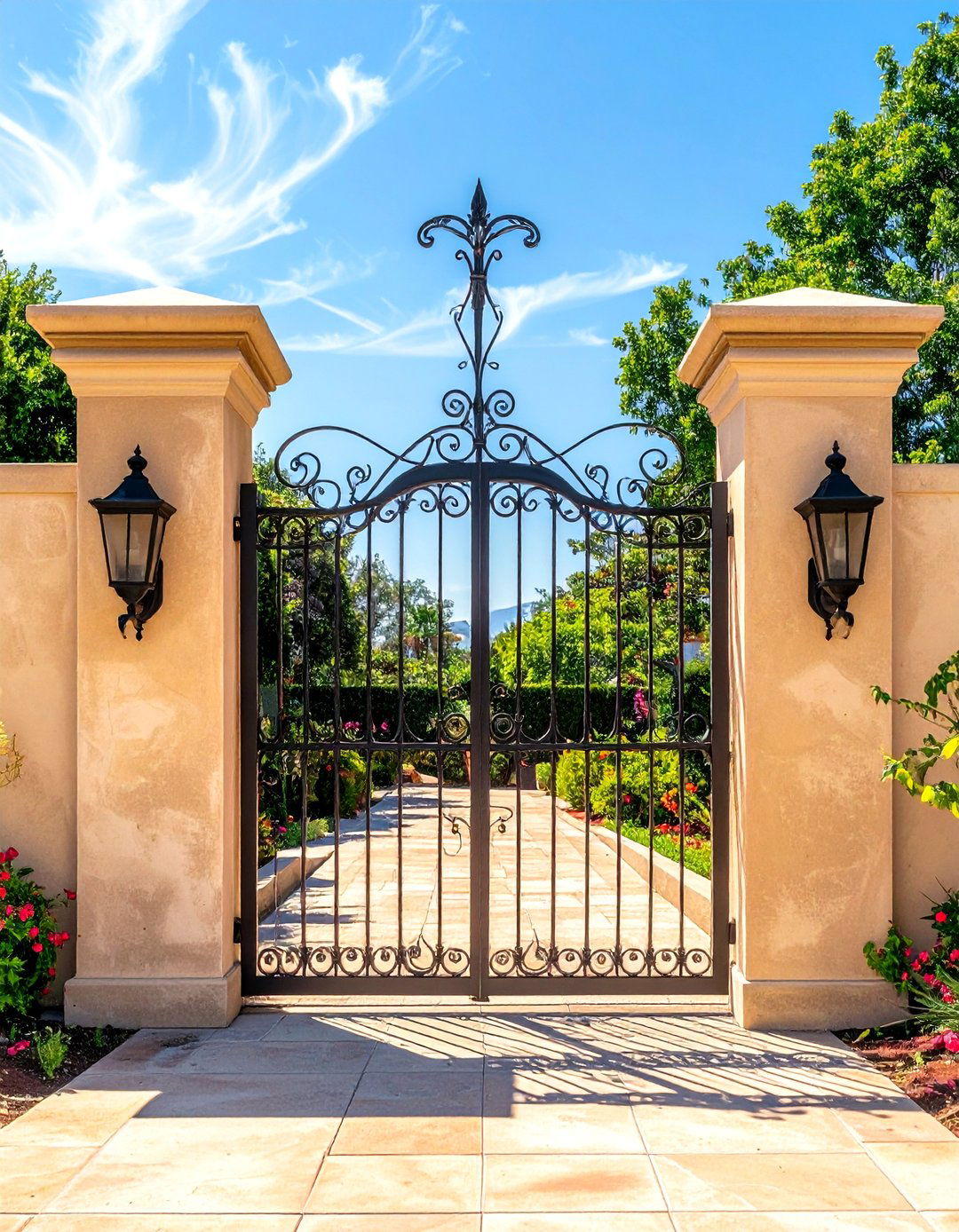
Incorporating wrought iron brings a touch of classic elegance and detailed craftsmanship to your front yard. A beautifully crafted wrought iron gate provides a secure yet visually open entrance, offering a glimpse into the garden beyond. Use matching fence panels to line the property or top low stucco walls for added height and security without obstructing the view. The dark, intricate scrollwork of the iron creates a stunning contrast against light-colored stucco or stone and pairs perfectly with the rustic wooden elements often found in Spanish architecture. This durable material not only adds beauty but also stands the test of time.
4. Gravel and Decomposed Granite Pathways
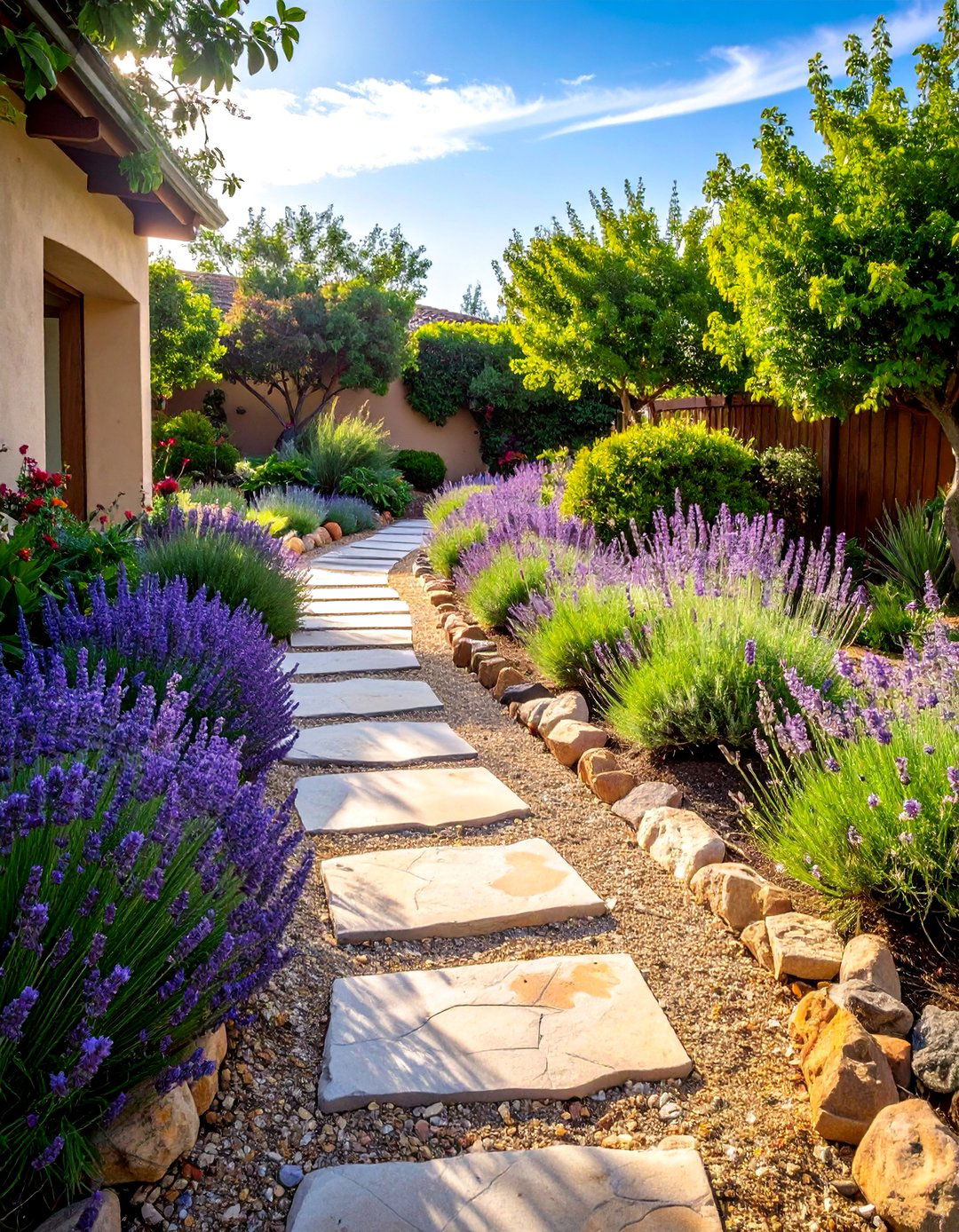
For an authentic and low-maintenance ground cover, gravel or decomposed granite pathways are an excellent choice. These materials provide a soft, crunchy texture underfoot and contribute to the rustic, sun-baked aesthetic of a Mediterranean landscape. Pea gravel in warm, earthy tones can be used to create winding paths that meander through garden beds, while decomposed granite offers a more stable, compacted surface for patios or main walkways. Edging the paths with natural stone or terracotta tiles helps to define the space and keep the material contained, resulting in a clean yet natural look that conserves water and reduces lawn care.
5. Bougainvillea Climbing a Feature Wall
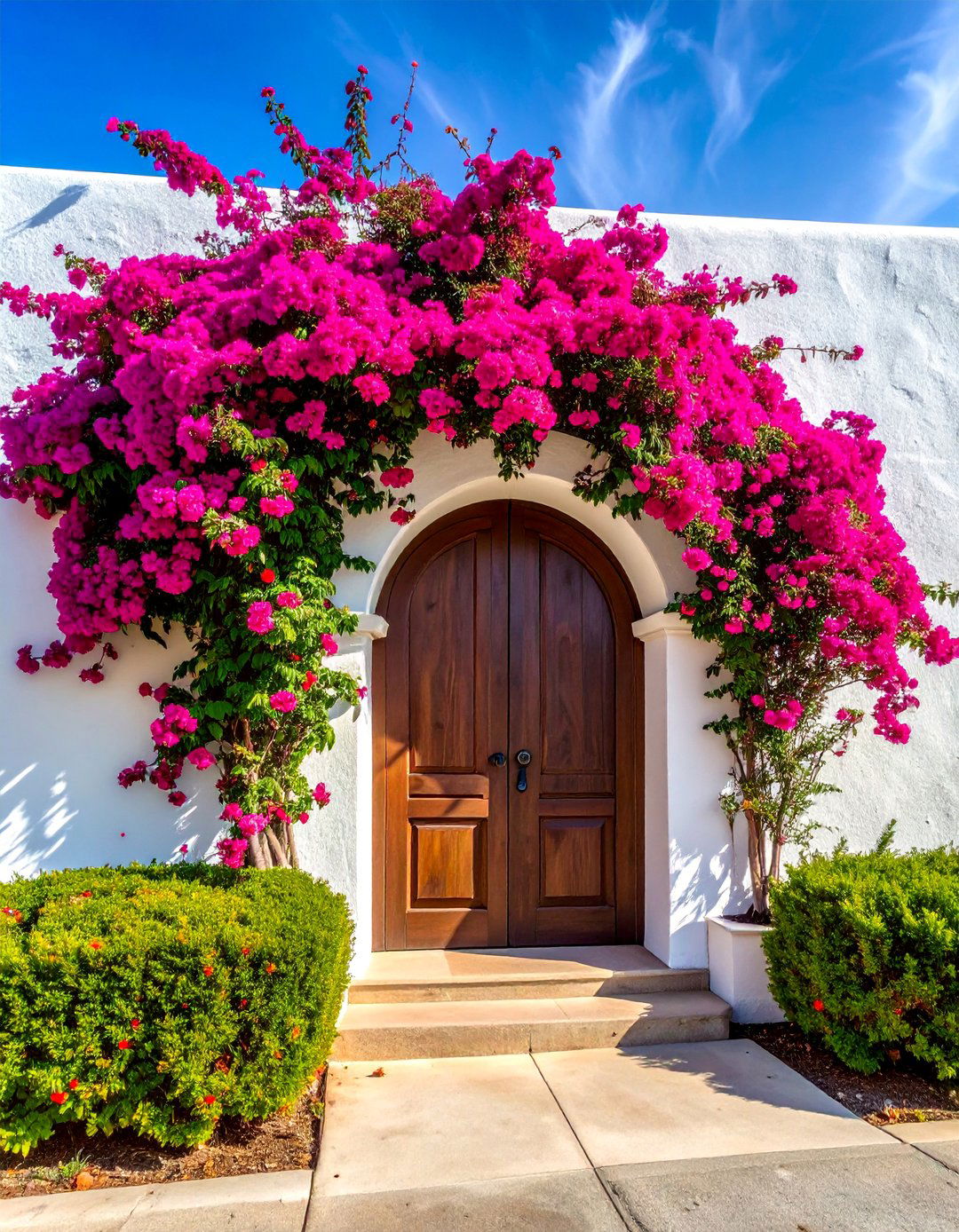
The vibrant, cascading color of bougainvillea is iconic in Spanish garden design. Train this hardy vine to climb a prominent front-facing wall, an archway, or a pergola to create a breathtaking floral display. The brilliant pink, purple, or red bracts stand out dramatically against the neutral backdrop of a white or beige stucco wall, providing a powerful pop of color. Bougainvillea thrives in sunny, dry conditions, making it an ideal choice for a water-wise landscape. Its vigorous growth and stunning appearance can instantly transform a simple architectural feature into a living work of art that captures the essence of Mediterranean charm.
6. Central Water Fountain Feature
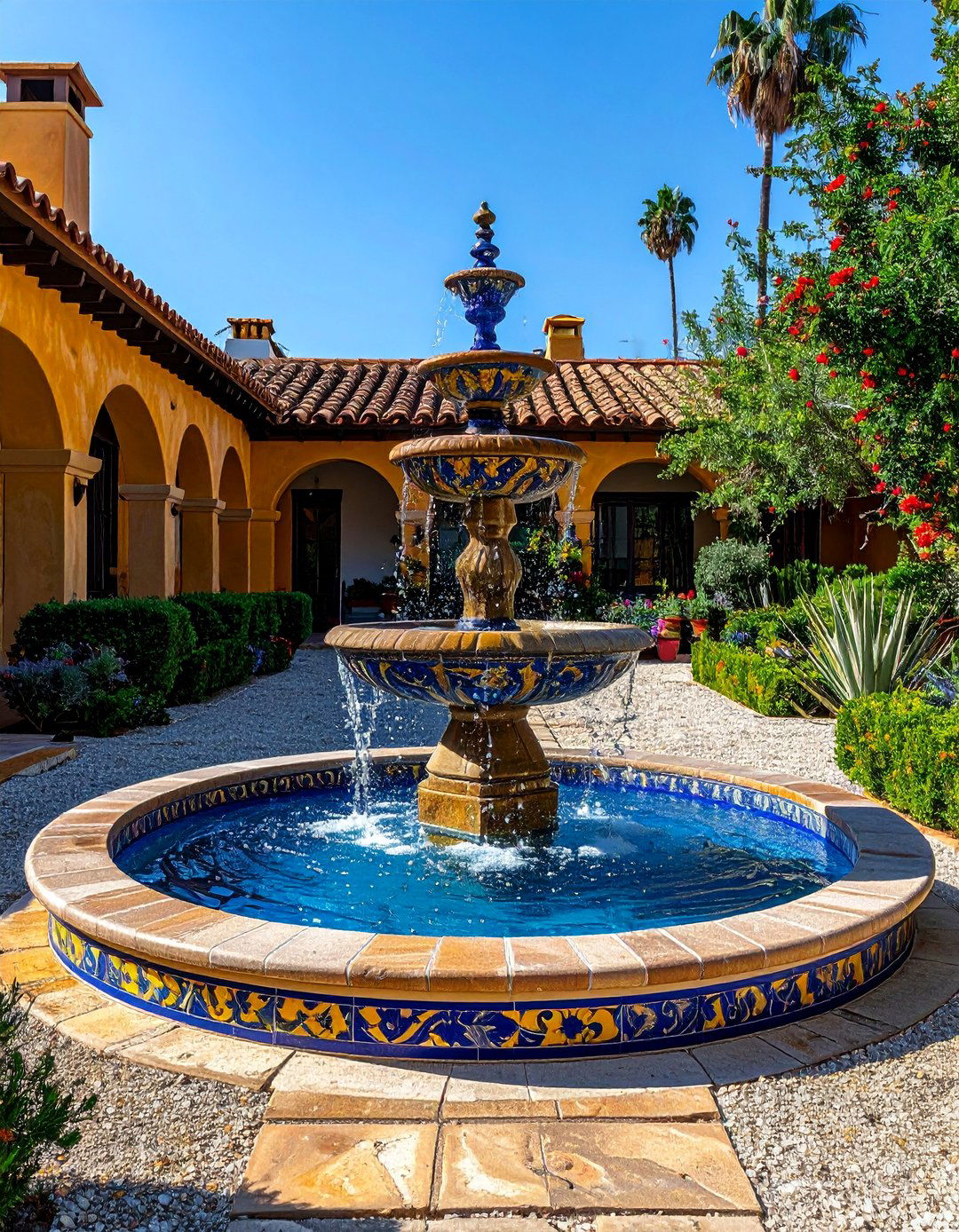
A central water feature, such as a tiered or wall-mounted fountain, serves as a classic focal point in a Spanish-style front yard. The gentle sound of trickling water creates a serene and cooling atmosphere, offering a respite from the heat. Fountains crafted from stone, concrete, or adorned with colorful Spanish tiles become a gathering spot for the senses. Position the fountain in the center of a courtyard or at a point where pathways converge to draw the eye and anchor the landscape design. Surrounding it with low-growing, fragrant herbs like lavender or thyme completes the tranquil and inviting scene.
7. Hand-Painted Tile Accents
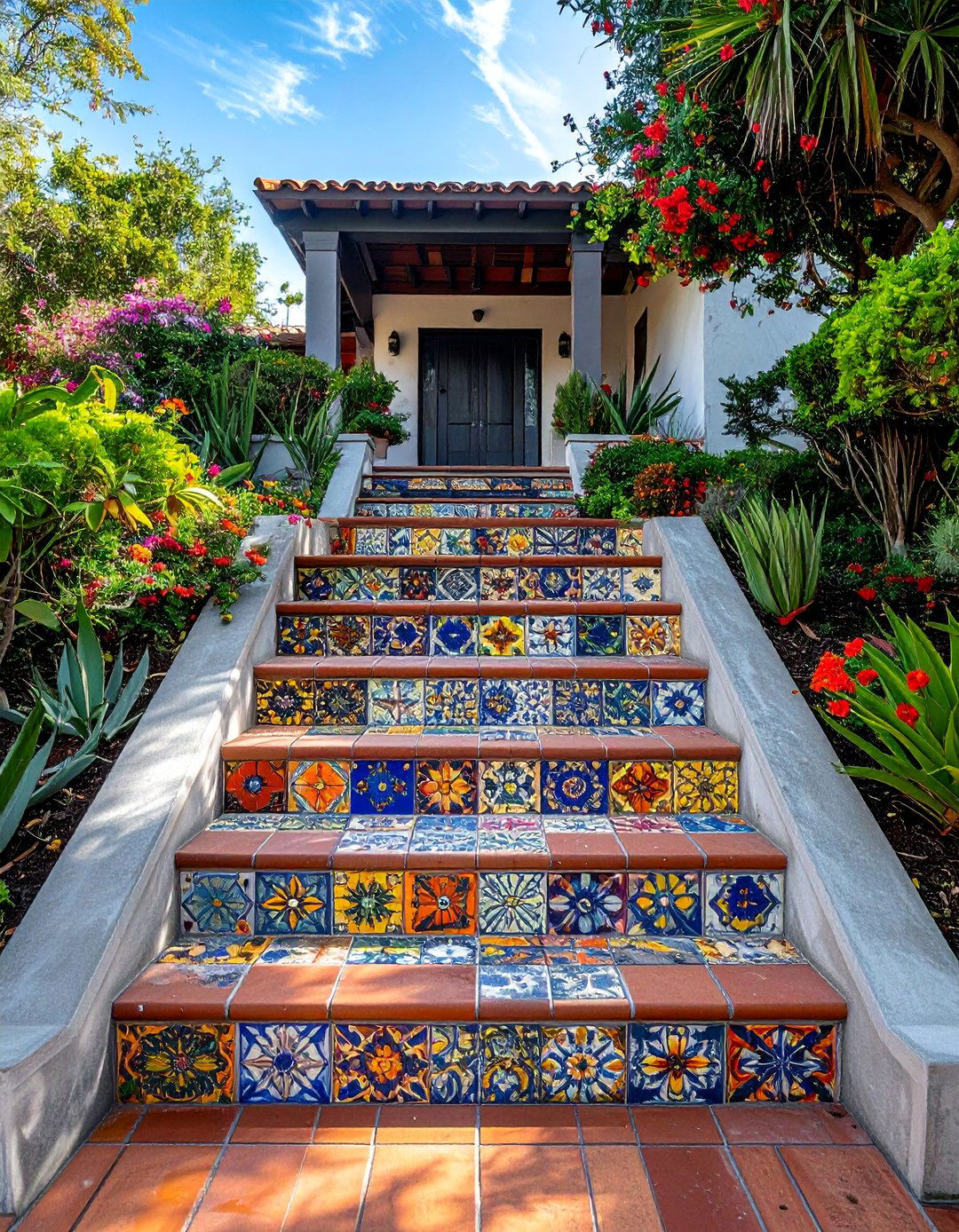
Incorporating hand-painted ceramic tiles adds a vibrant splash of color and intricate pattern to the landscape. Use these decorative tiles to adorn stair risers, the face of a wall fountain, or as a border for a patio or walkway. The bold blues, yellows, and greens found in traditional Spanish tile designs create a lively contrast with the earthy tones of stone, stucco, and terracotta. This small detail can have a major impact, infusing the space with personality and a sense of handcrafted artistry. Choosing patterns that reflect Moorish influences further enhances the authenticity of the design, connecting your yard to centuries of tradition.
8. Olive Trees as Specimen Plants
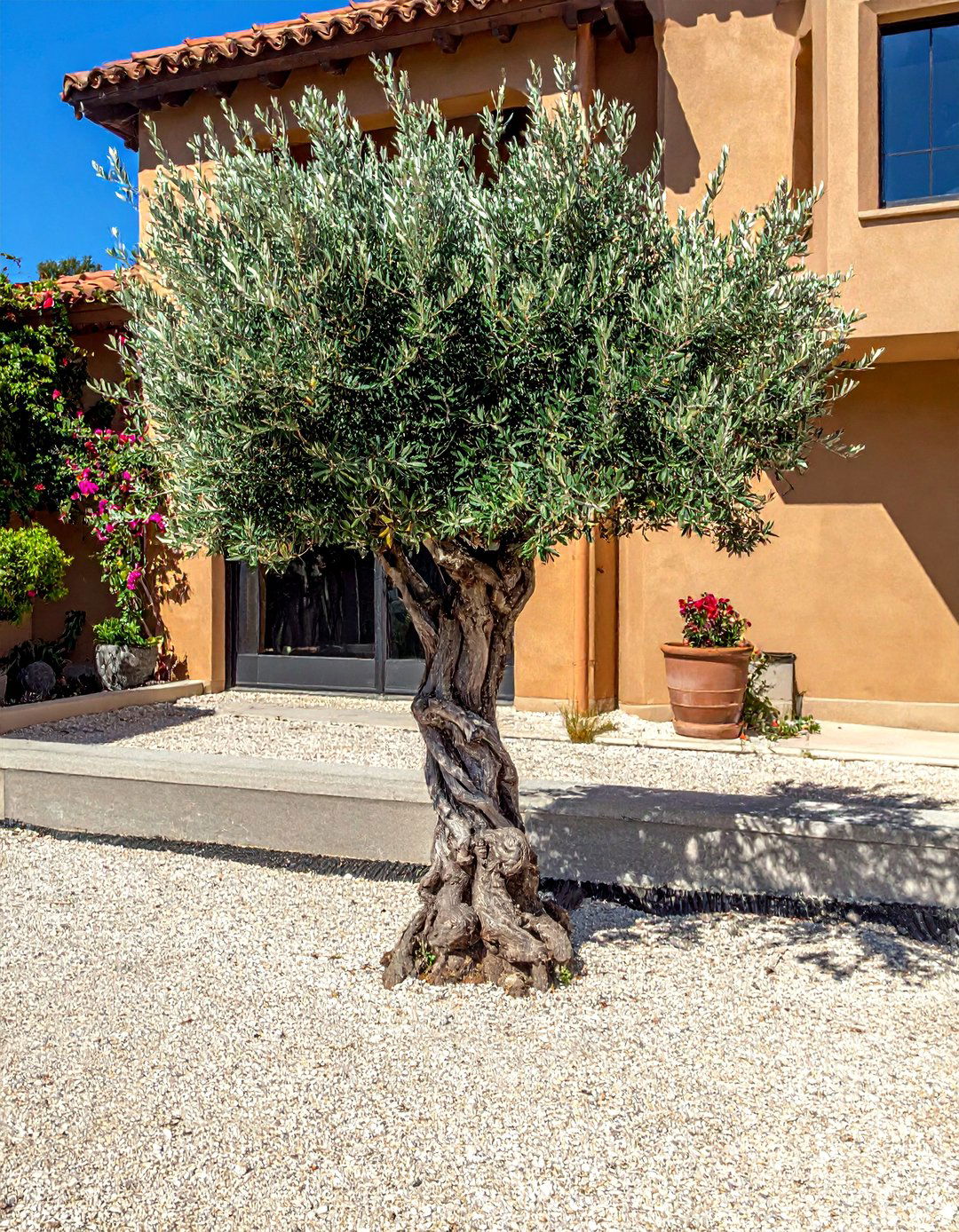
An olive tree, with its silvery-green foliage and gnarled, ancient-looking trunk, is a quintessential element of Mediterranean landscapes. Planting one or two as specimen trees in the front yard adds a sense of history and understated elegance. Their sculptural form provides a natural focal point whether planted directly in a gravel bed or showcased in a large terracotta urn. Olive trees are incredibly drought-tolerant and thrive in full sun, making them a practical and beautiful choice for a Spanish-style garden. They provide light, dappled shade and evoke the sun-drenched hillsides of Spain, anchoring the entire design with their timeless appeal.
9. Drought-Tolerant Succulent and Agave Gardens
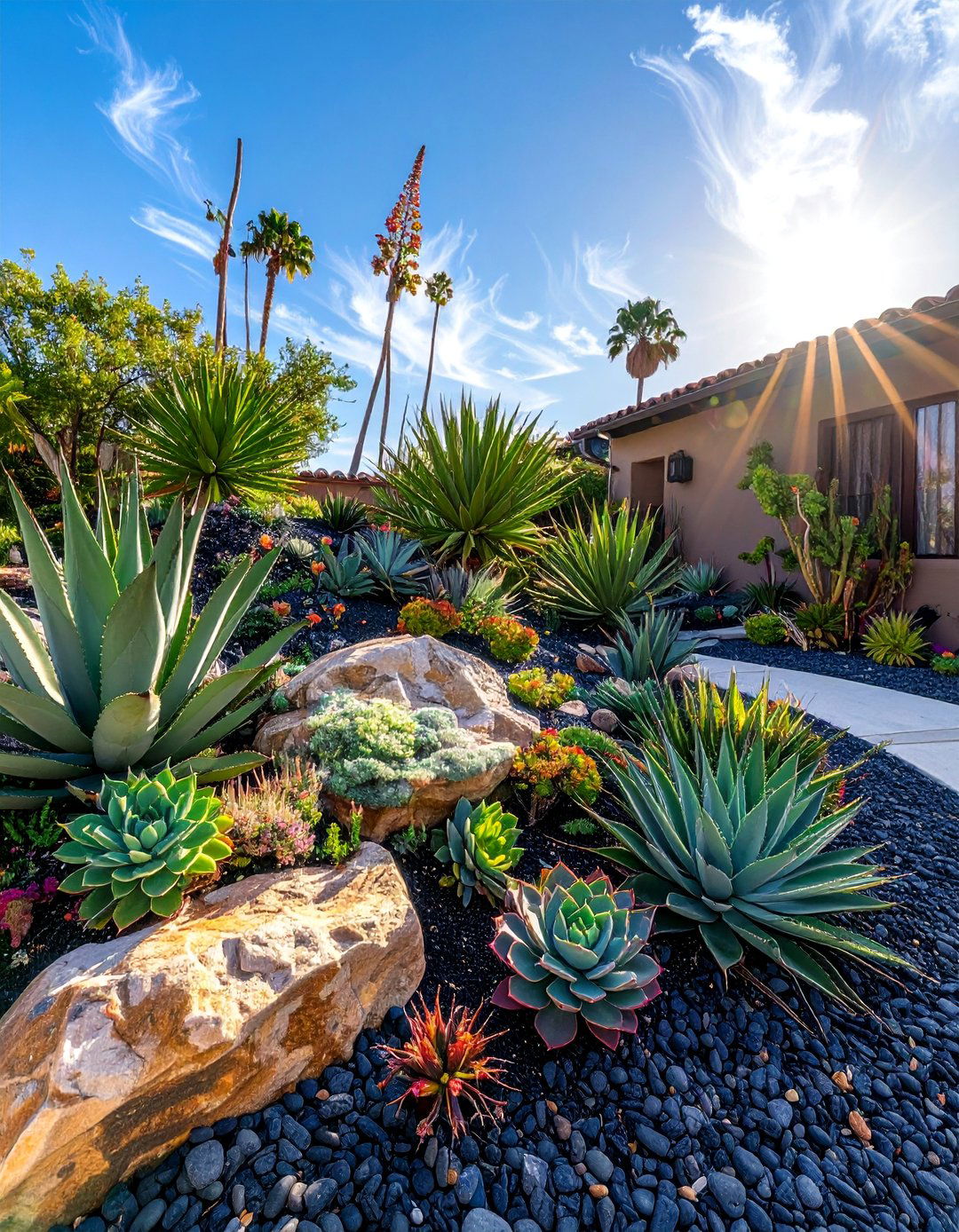
Creating a dedicated garden bed filled with succulents and agaves perfectly aligns with the water-wise principles of Spanish landscaping. These plants offer a stunning variety of shapes, textures, and colors, from the sharp, architectural lines of the agave to the soft, rosette forms of echeverias. Arrange them in a bed of gravel or decomposed granite, interspersed with a few natural boulders for added dimension. This type of garden is exceptionally low-maintenance and thrives in hot, sunny conditions. It provides year-round visual interest and a modern twist on the classic Mediterranean aesthetic while celebrating the beauty of drought-resistant flora.
10. Aromatic Lavender and Rosemary Borders
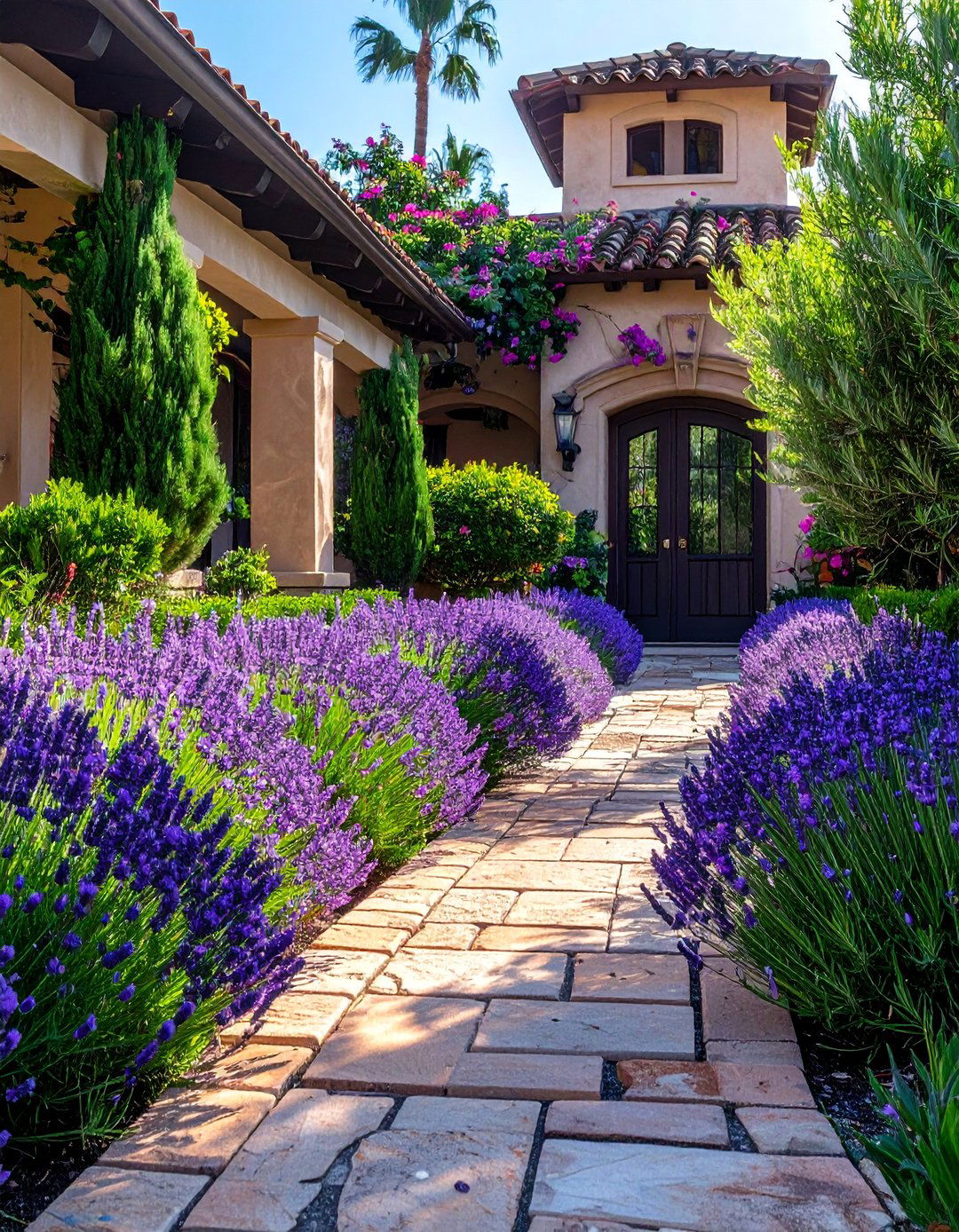
Line your front walkways or garden beds with borders of aromatic herbs like lavender and rosemary to engage all the senses. The silvery-green foliage and purple spikes of lavender create a soft, textural edge, while rosemary offers a deeper green and a wonderful, resinous scent. Both plants are drought-tolerant and release their fragrance when brushed against, welcoming guests as they approach your home. This practical design choice not only adds beauty and aroma but also provides a source of fresh herbs for your kitchen. The Mediterranean origin of these plants makes them a natural fit for a Spanish-style landscape.
11. Rustic Wooden Pergola Over a Walkway
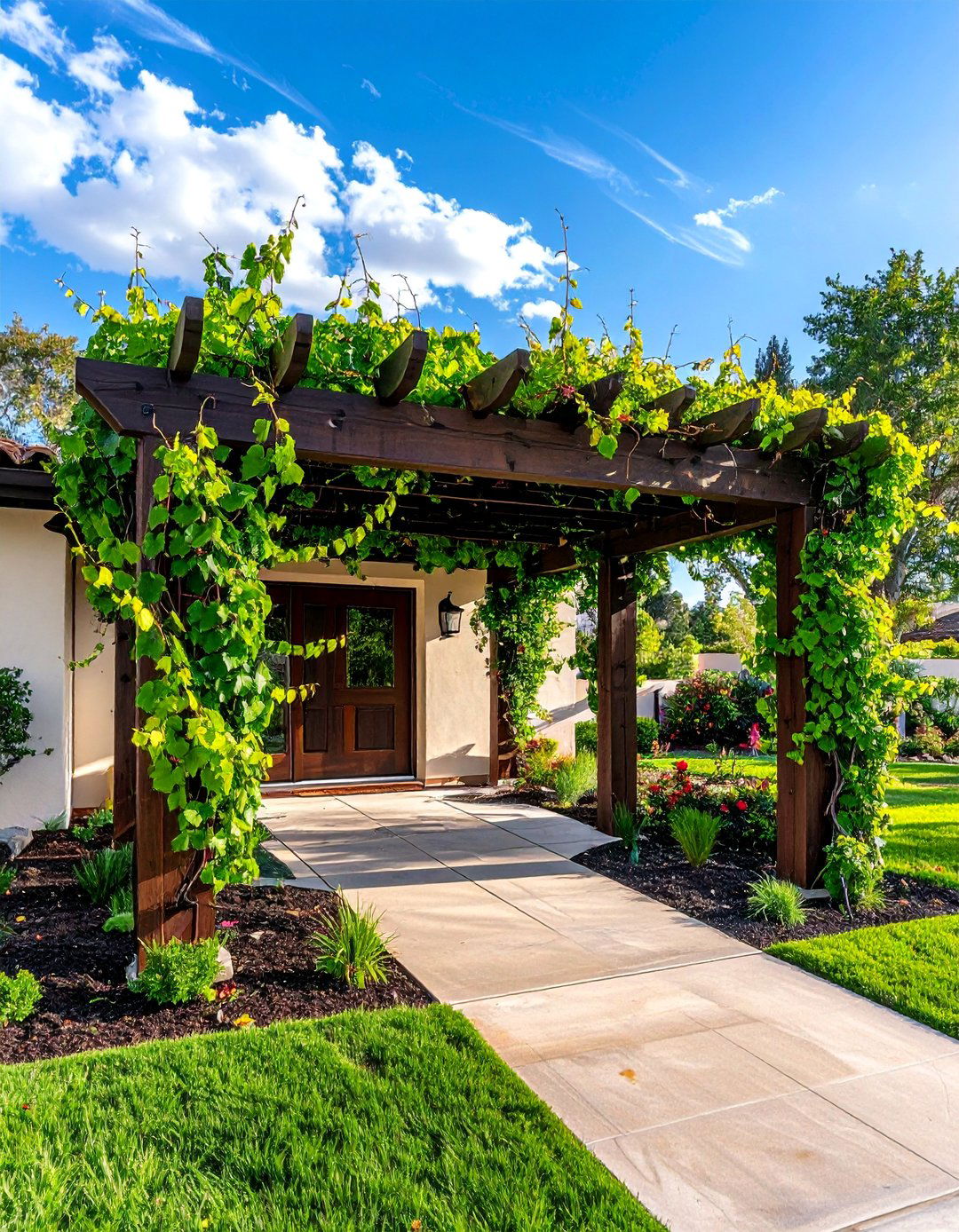
A rustic wooden pergola adds architectural interest and much-needed shade to a Spanish-style front yard. Construct it from heavy, dark-stained timbers to create a substantial and authentic structure. Place it over a main walkway leading to the front door or over a small seating area to define the space. Train climbing plants like bougainvillea, trumpet vine, or grapevines to grow over the top, which will provide a beautiful, leafy canopy and dappled sunlight. This feature not only enhances the aesthetic but also extends the usability of your outdoor space, creating a comfortable and inviting transition from the garden to the home.
12. Symmetrical Layout with Boxwood Hedges
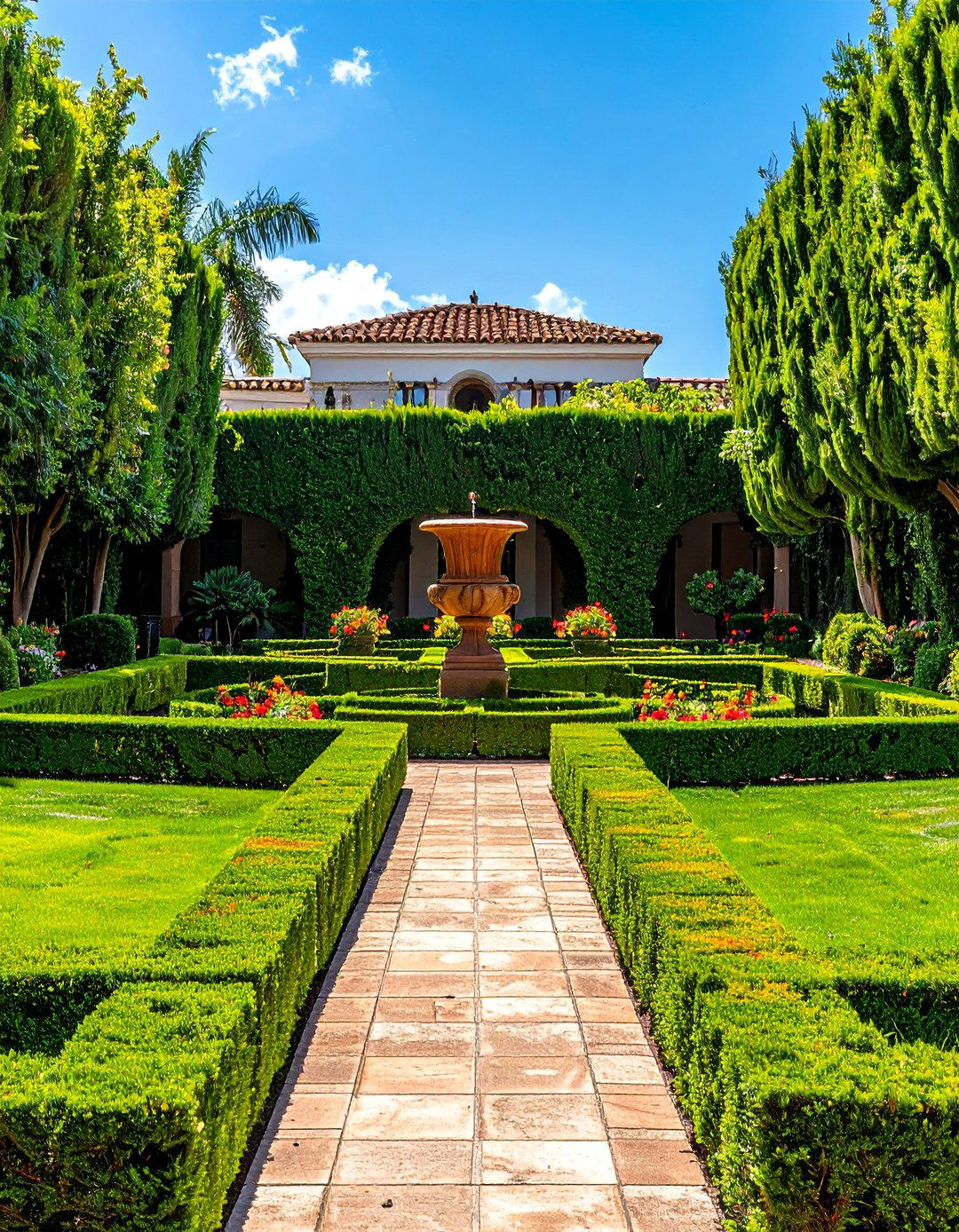
For a more formal and classic Spanish garden look, implement a symmetrical layout. This can be achieved by creating balanced garden beds on either side of a central pathway or flanking the front entrance with identical plantings. Low-growing, clipped boxwood hedges are perfect for outlining these formal beds or creating geometric patterns, a design concept with roots in historic Spanish gardens. This sense of order and balance provides a structured framework that contrasts beautifully with the softer, more natural forms of flowering plants and ornamental grasses within the beds, resulting in a landscape that feels both manicured and timelessly elegant.
13. Natural Stone Retaining Walls
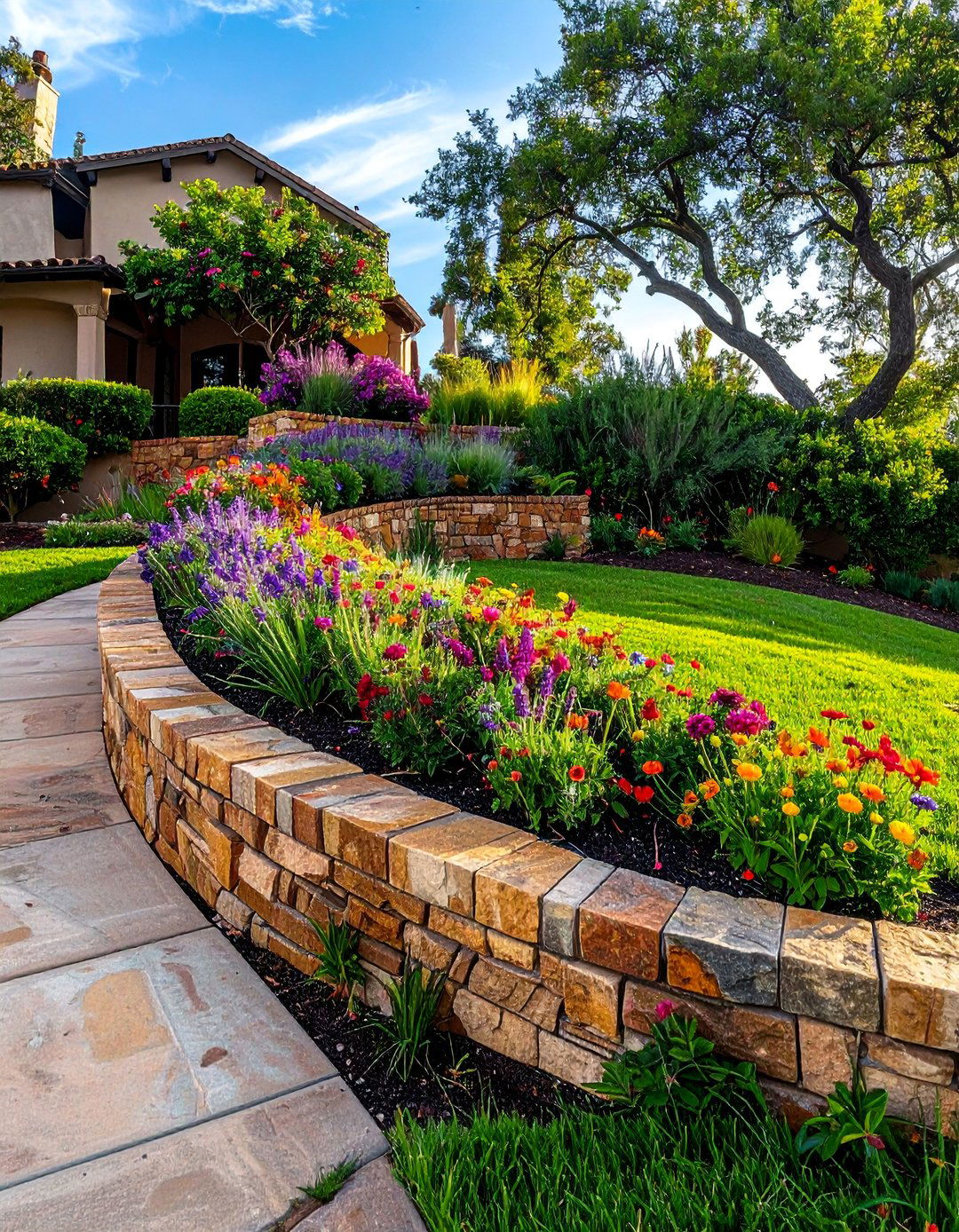
Using natural stone to build low retaining walls adds texture, dimension, and an organic feel to the front yard. These walls are perfect for terracing a sloped yard or for creating raised garden beds, which can improve drainage and make planting easier. Choose a stone that complements the colors of your home and other hardscaping materials, such as a warm-toned flagstone or rugged fieldstone. The rough, natural surface of the stone provides a beautiful contrast to the smooth finish of stucco walls and the soft textures of plants, grounding the landscape with a sense of permanence and rustic authenticity.
14. Integrated Lantern-Style Outdoor Lighting
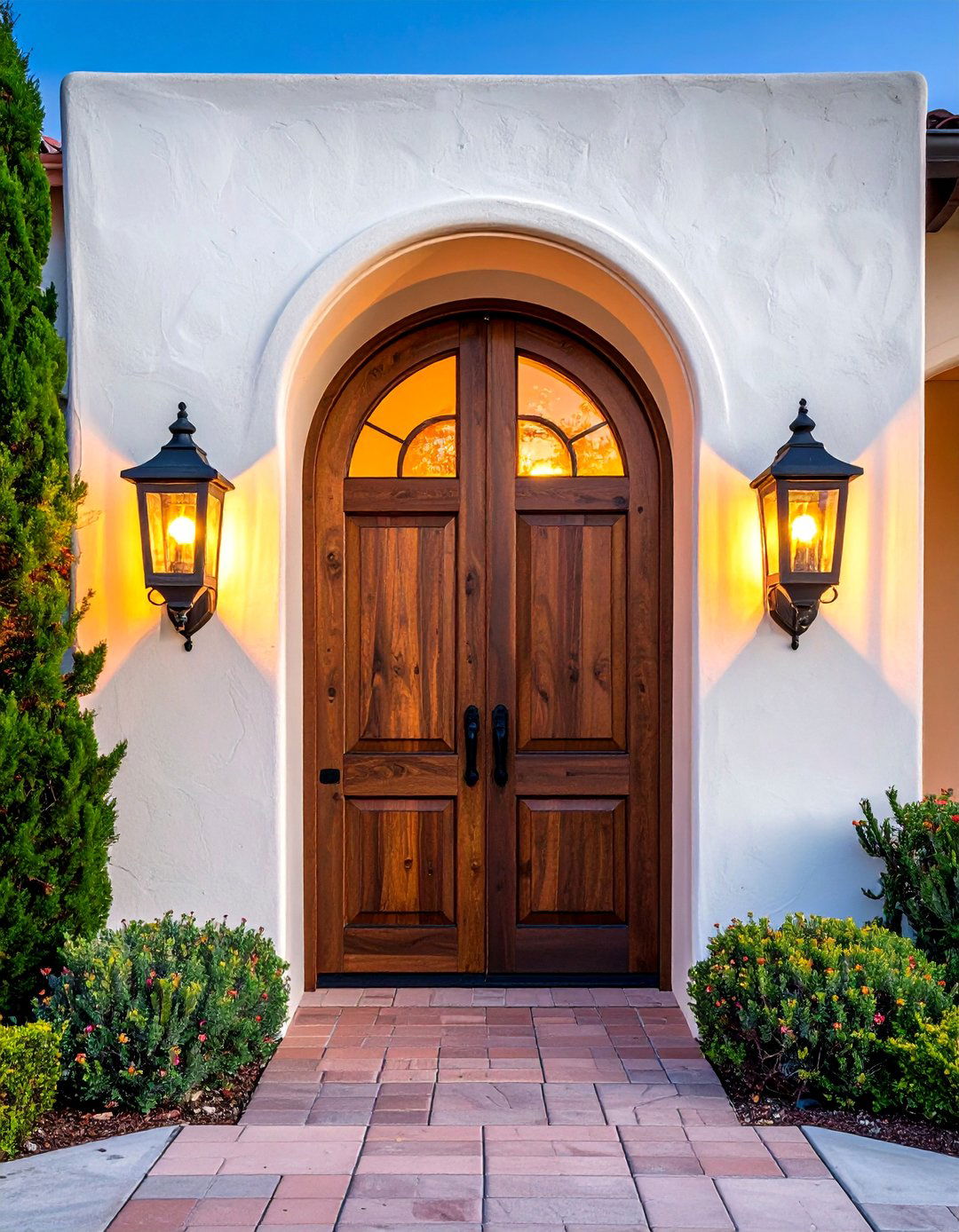
Proper lighting is key to highlighting the beauty of your Spanish landscape after sunset. Choose lantern-style fixtures made from wrought iron or dark bronze to maintain the aesthetic. Install wall-mounted sconces on either side of the front door, hang a pendant lantern from a pergola, or place path lights along walkways to ensure safe navigation. The warm, gentle glow from these fixtures will accentuate the textures of stucco walls, cast intriguing shadows through the foliage of olive trees, and create a welcoming and romantic ambiance. This functional element adds another layer of charm and sophistication to the overall design.
15. A Secluded Bench Seating Nook
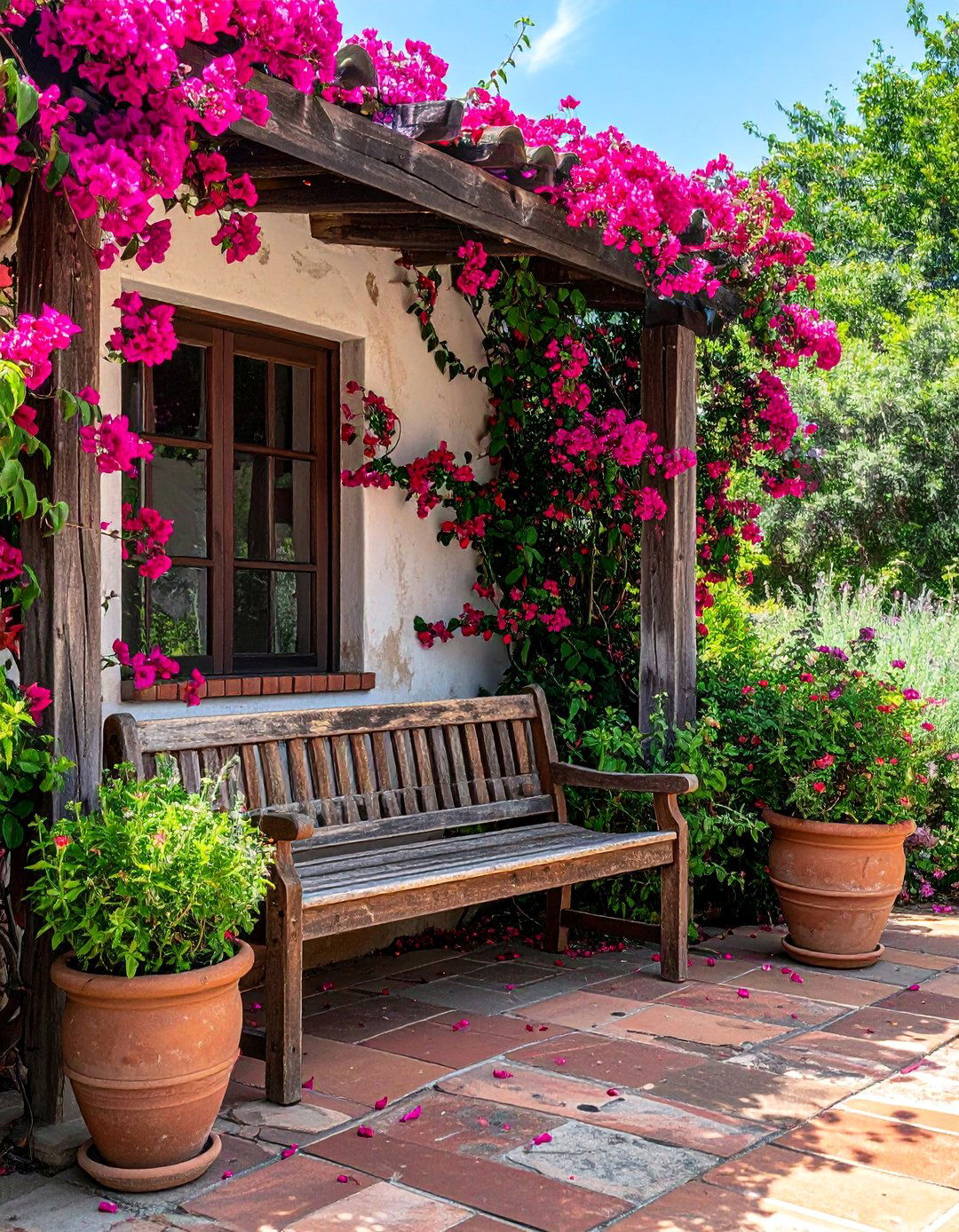
Create a small, secluded nook in your front yard to serve as a quiet spot for relaxation. A simple wooden or stone bench tucked into a corner, perhaps under the shade of an olive tree or beside a fragrant rosemary bush, can become a cherished retreat. Surround the seating area with low walls or lush plantings to enhance the sense of privacy and enclosure. Pave the area with flagstone or decomposed granite and add a few terracotta pots with colorful flowers to complete the scene. This thoughtful addition transforms a simple garden into a functional outdoor room, inviting you to spend more time enjoying its beauty.
16. Palm Trees for Vertical Interest
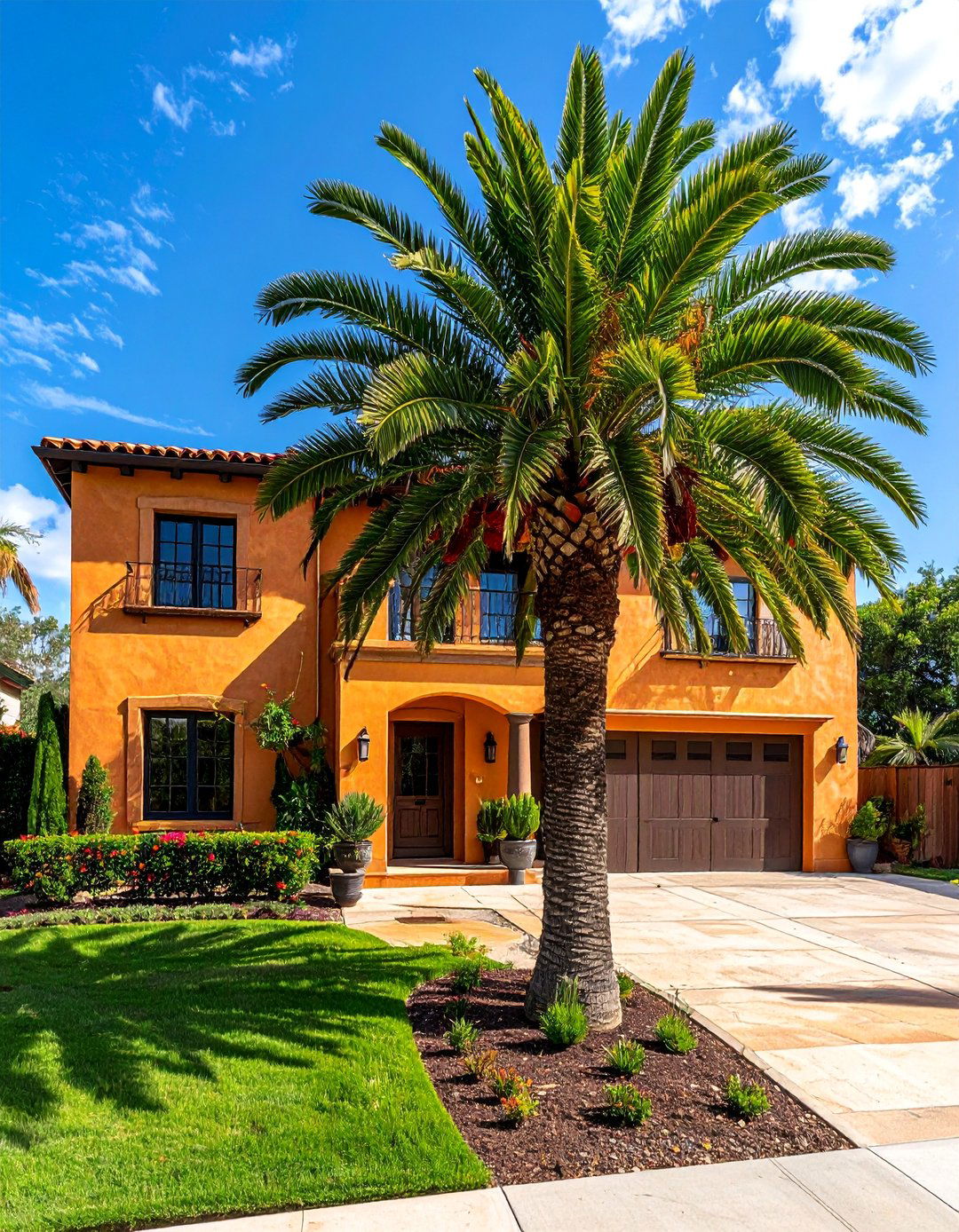
For a Spanish landscape with a touch of coastal or Moorish influence, consider incorporating one or more palm trees. Species like the Mediterranean Fan Palm offer a compact, clumping form that works well in smaller yards, while taller varieties can create dramatic vertical accents. Their bold, tropical foliage adds a different texture to the garden, contrasting nicely with the fine leaves of olive trees or the softness of lavender. Palm trees are relatively low-maintenance and reinforce the sun-drenched, resort-like feel of the design, instantly elevating the curb appeal and making a strong architectural statement against the sky.
17. Use of Citrus Trees in Large Urns
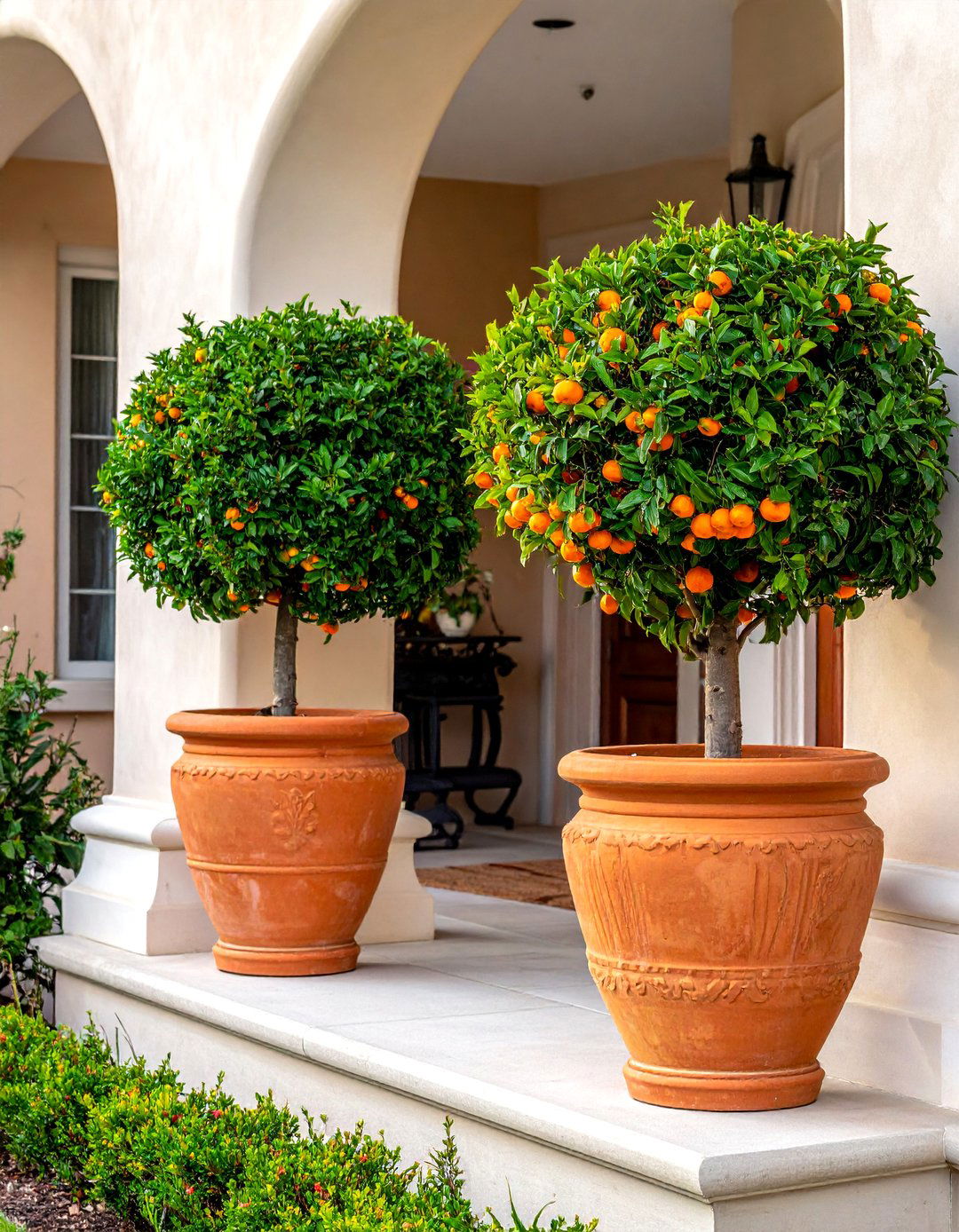
Planting dwarf citrus trees, such as lemon or orange, in large earthenware urns adds both beauty and function to your front yard. The vibrant green leaves, fragrant white blossoms, and colorful fruit provide year-round interest. Placing these large potted trees on either side of your front door or at the corners of a patio creates a welcoming and symmetrical focal point. This container gardening approach allows you to control the soil and moisture levels, which is especially beneficial for citrus. It’s a classic Mediterranean touch that brings a delightful combination of color, fragrance, and the promise of a fresh harvest.
18. Arched Entryways and Garden Gates
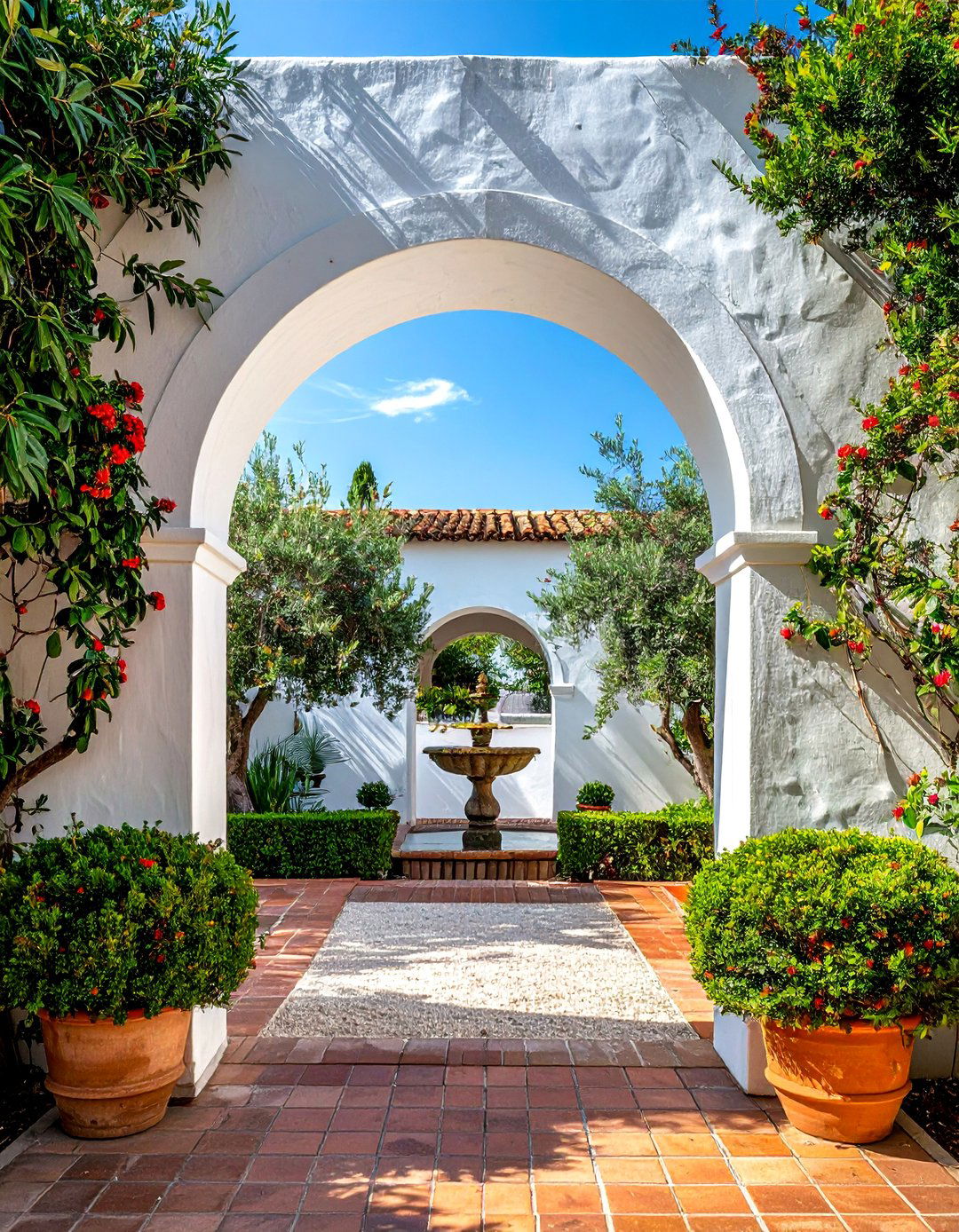
The arch is a hallmark of Spanish and Moorish architecture, and incorporating this shape into your landscape design creates an immediate sense of authenticity. An arched entryway in a stucco garden wall provides a graceful and inviting portal into a front courtyard. Similarly, a wooden or wrought iron garden gate with an arched top adds a touch of elegance and old-world charm. This simple architectural element can soften the hard lines of walls and fences, frame a beautiful view of the garden beyond, and establish a clear and beautiful transition from the public space of the street to the private sanctuary of your home.
19. Dry Creek Bed for Natural Drainage
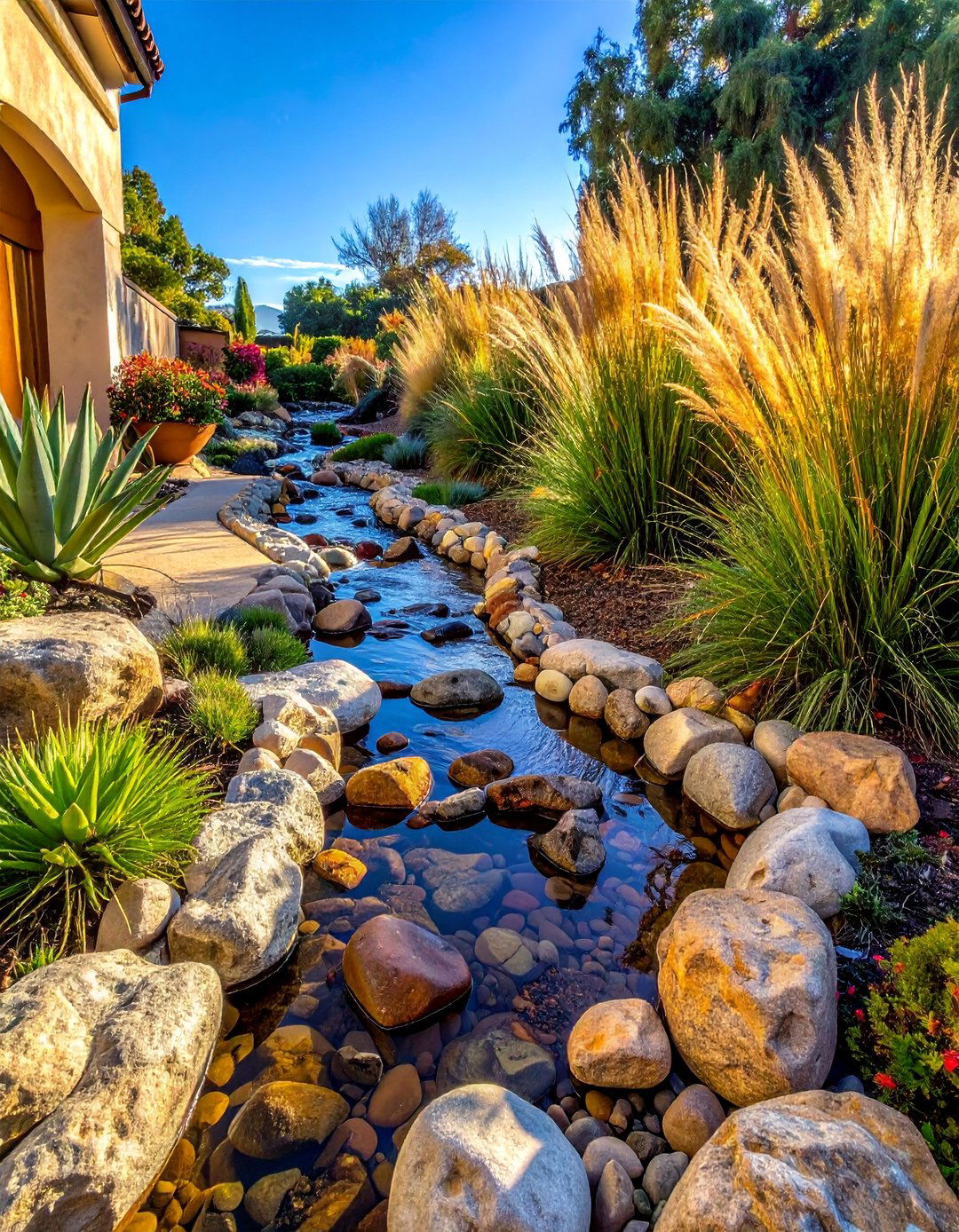
A dry creek bed is a functional and aesthetically pleasing feature that fits perfectly within a water-wise Spanish landscape. Constructed with a mix of river rocks, pebbles, and small boulders, it mimics a natural stream and provides an effective solution for managing rainwater runoff. Meander the creek bed through a garden area planted with drought-tolerant grasses, agaves, and other native plants. This element adds textural contrast and a sense of movement to the yard even when dry. It’s a sustainable design choice that solves a practical problem while enhancing the natural, rustic beauty of the overall landscape.
20. Window Boxes with Trailing Flowers
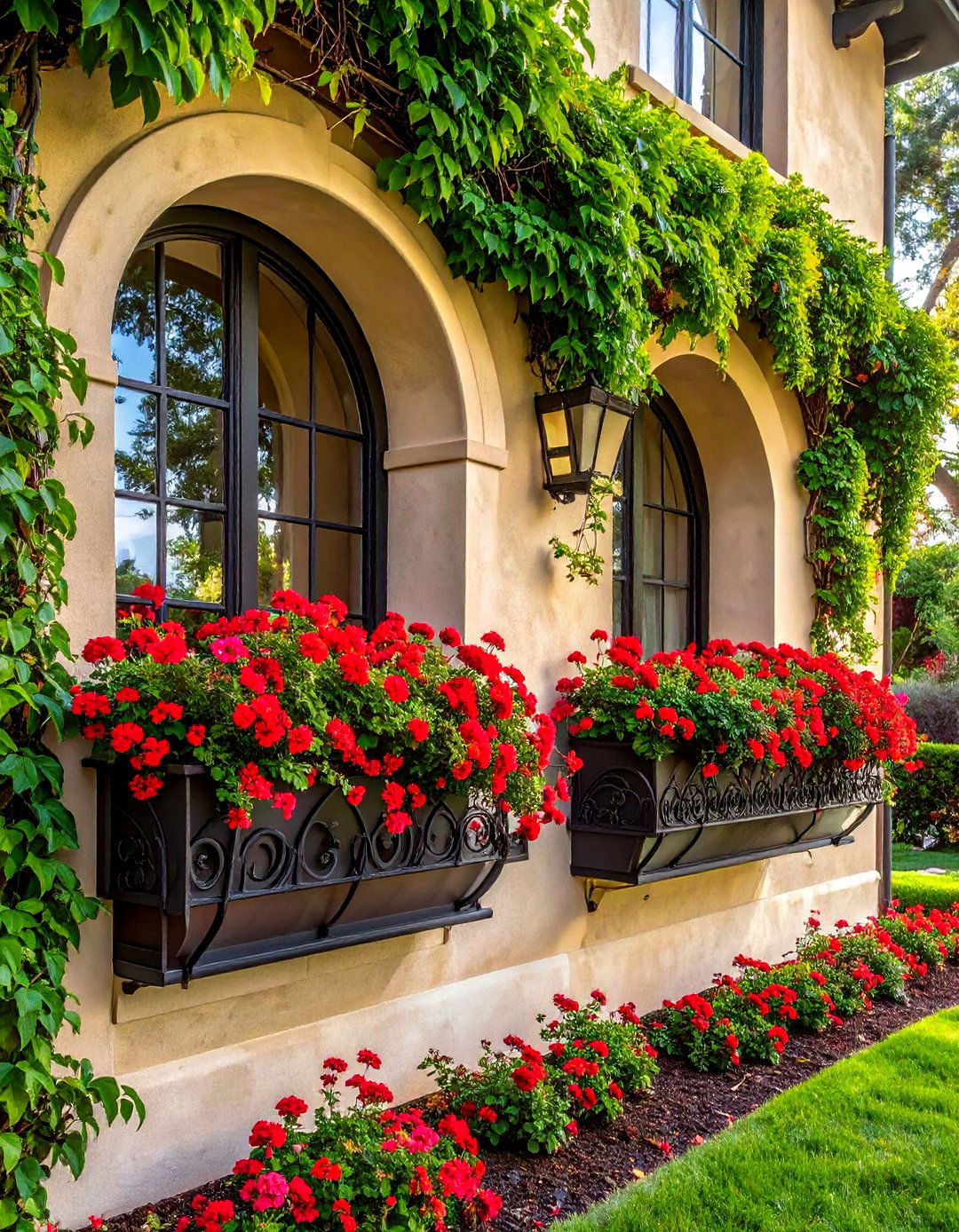
Install wrought iron or wooden window boxes beneath front-facing windows to add another layer of color and charm. Plant them with a profusion of trailing flowers like red geraniums, petunias, or ivy that will spill over the edges, softening the home's facade. This classic European touch works beautifully with Spanish-style architecture, connecting the home directly to the garden. It draws the eye upward and provides an opportunity to introduce vibrant color at a different level. Coordinated plantings in window boxes, ground-level pots, and garden beds create a cohesive and lush appearance that enhances the home’s curb appeal.
Conclusion:
Embracing front yard Spanish-style landscaping allows you to create an outdoor space that is rich in history, texture, and natural beauty. By focusing on core elements like stucco walls, terracotta, wrought iron, and water-wise plants, you can design a garden that is both stunning and sustainable. Whether you opt for a formal, symmetrical layout or a more rustic, naturalistic approach, this timeless style turns your front yard into a welcoming extension of your home. It’s a celebration of outdoor living that offers a warm, inviting welcome to all who arrive.

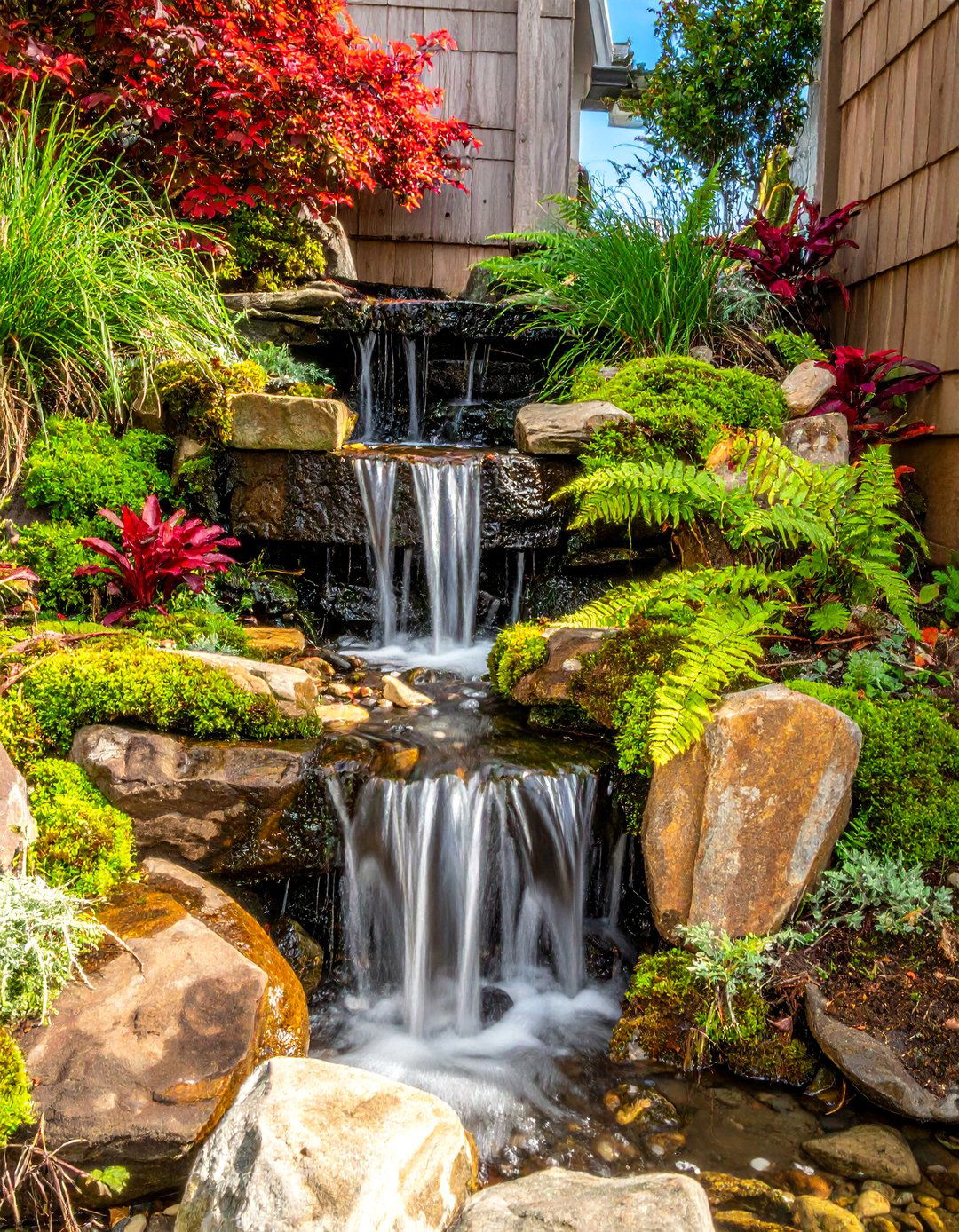
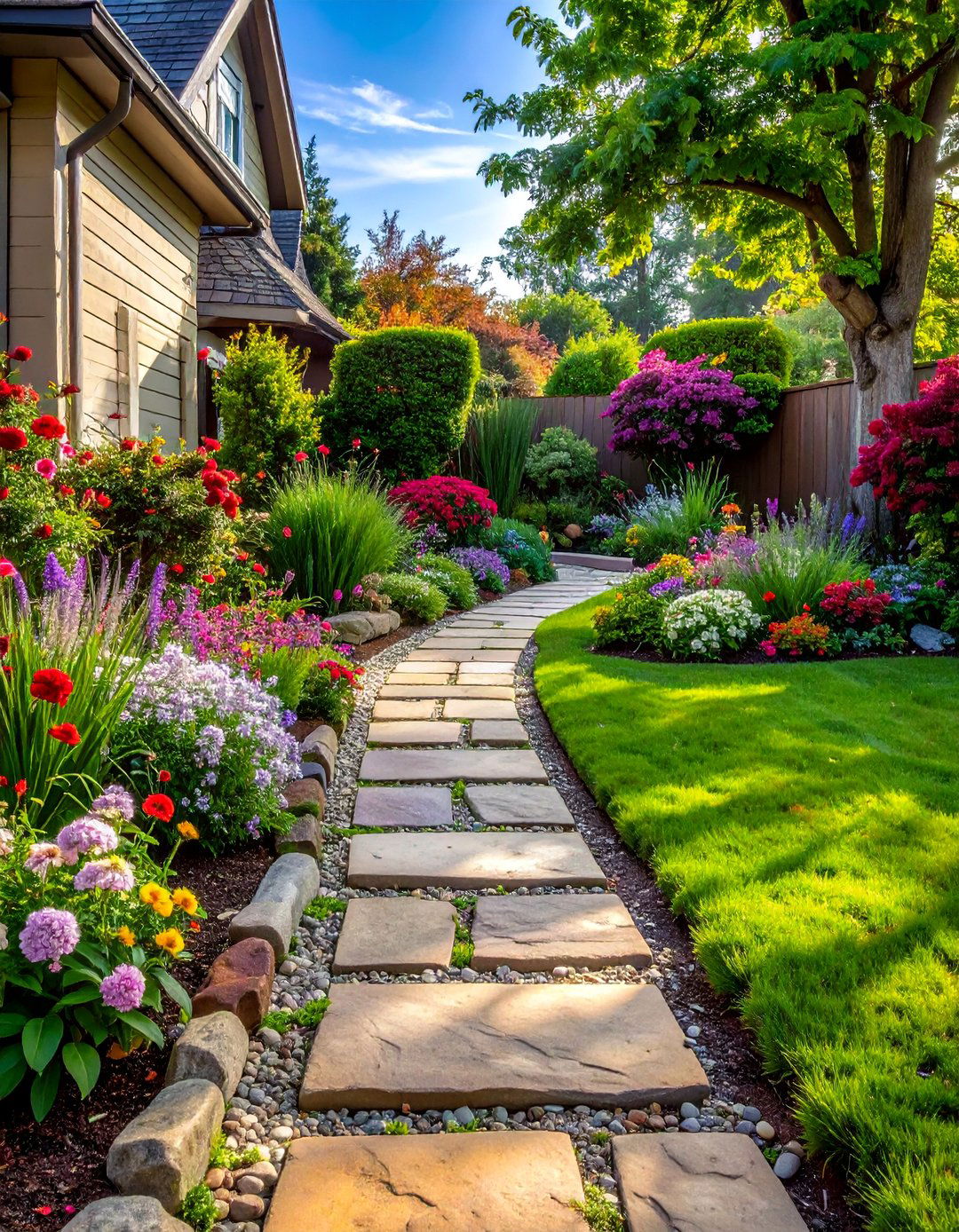
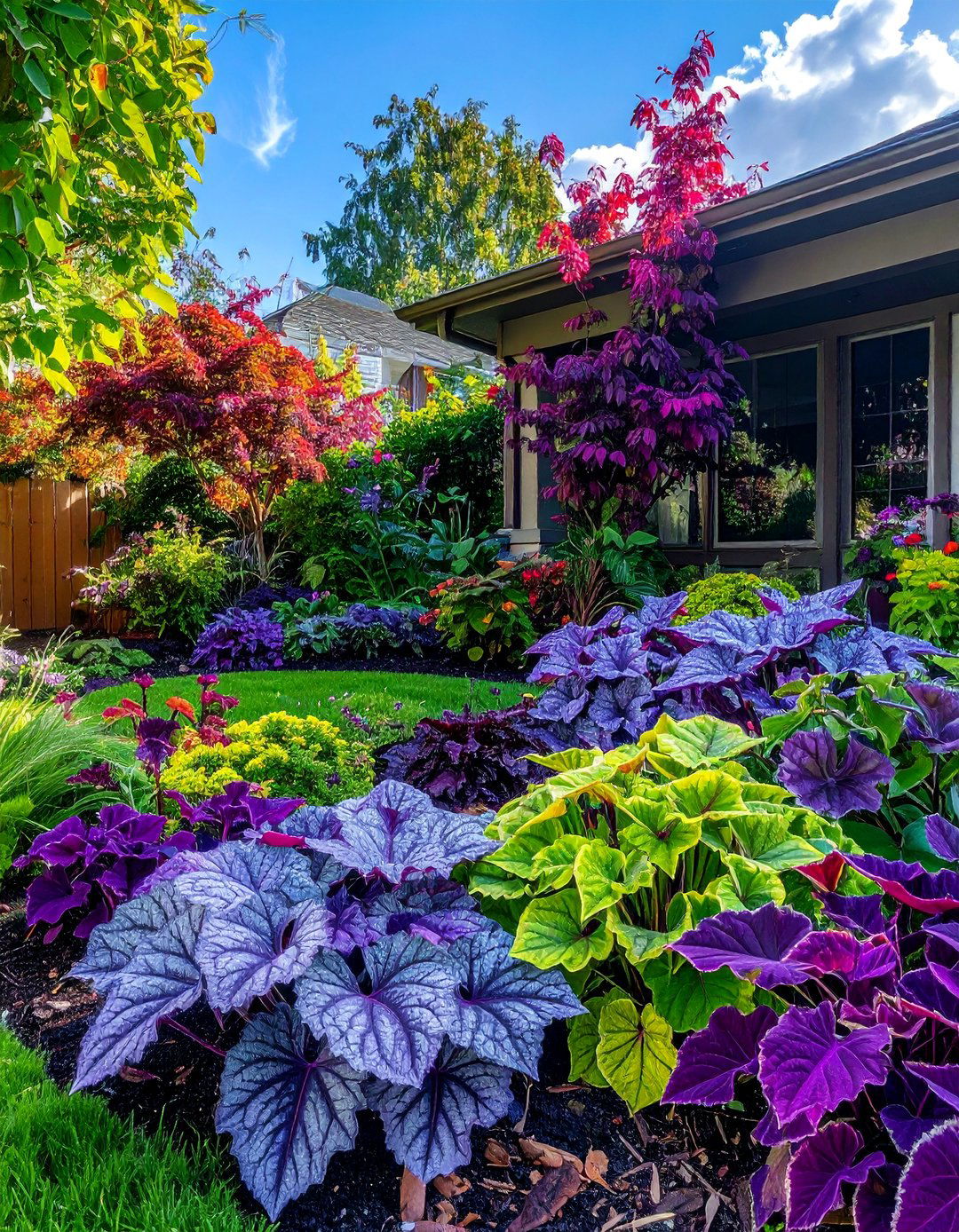
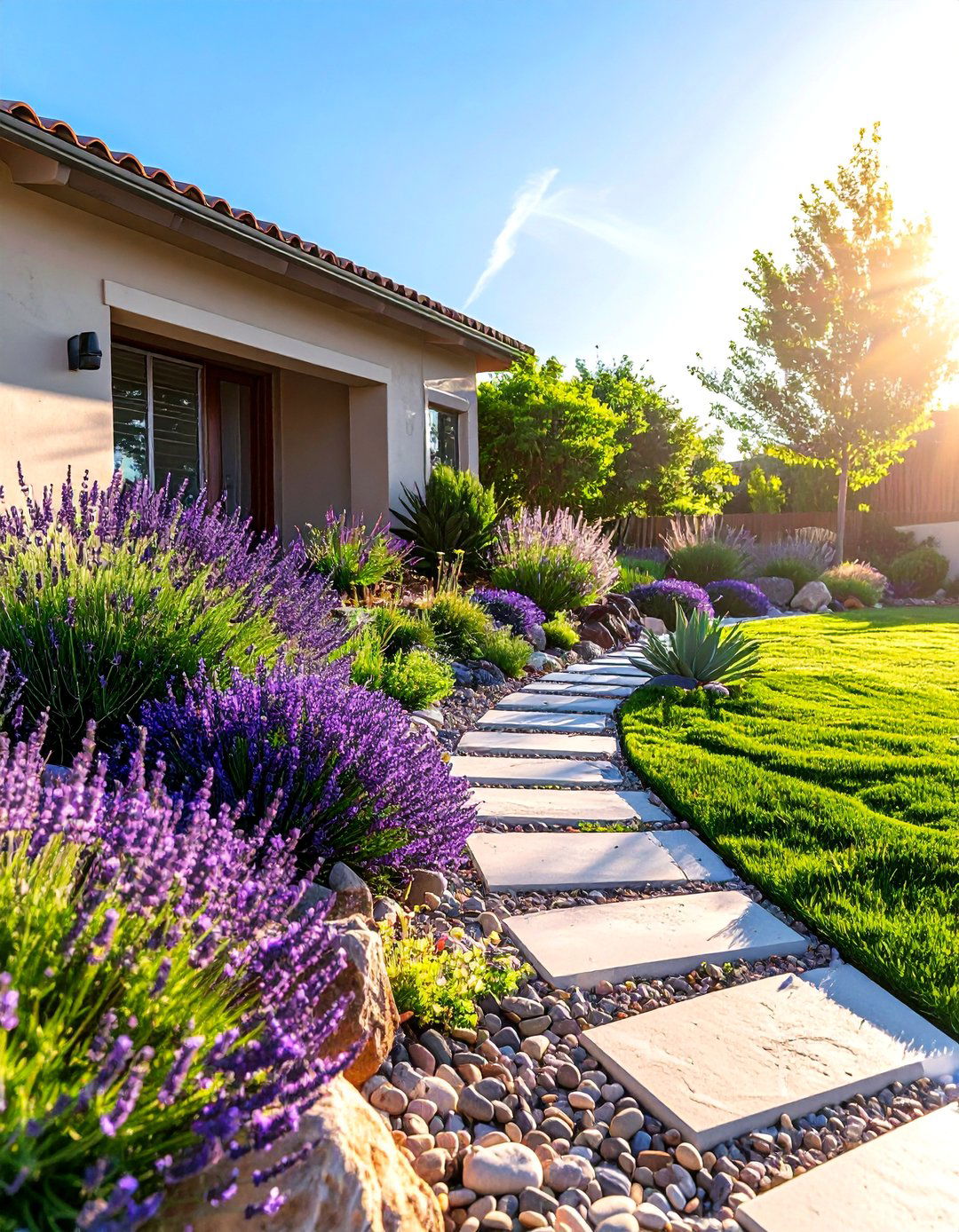
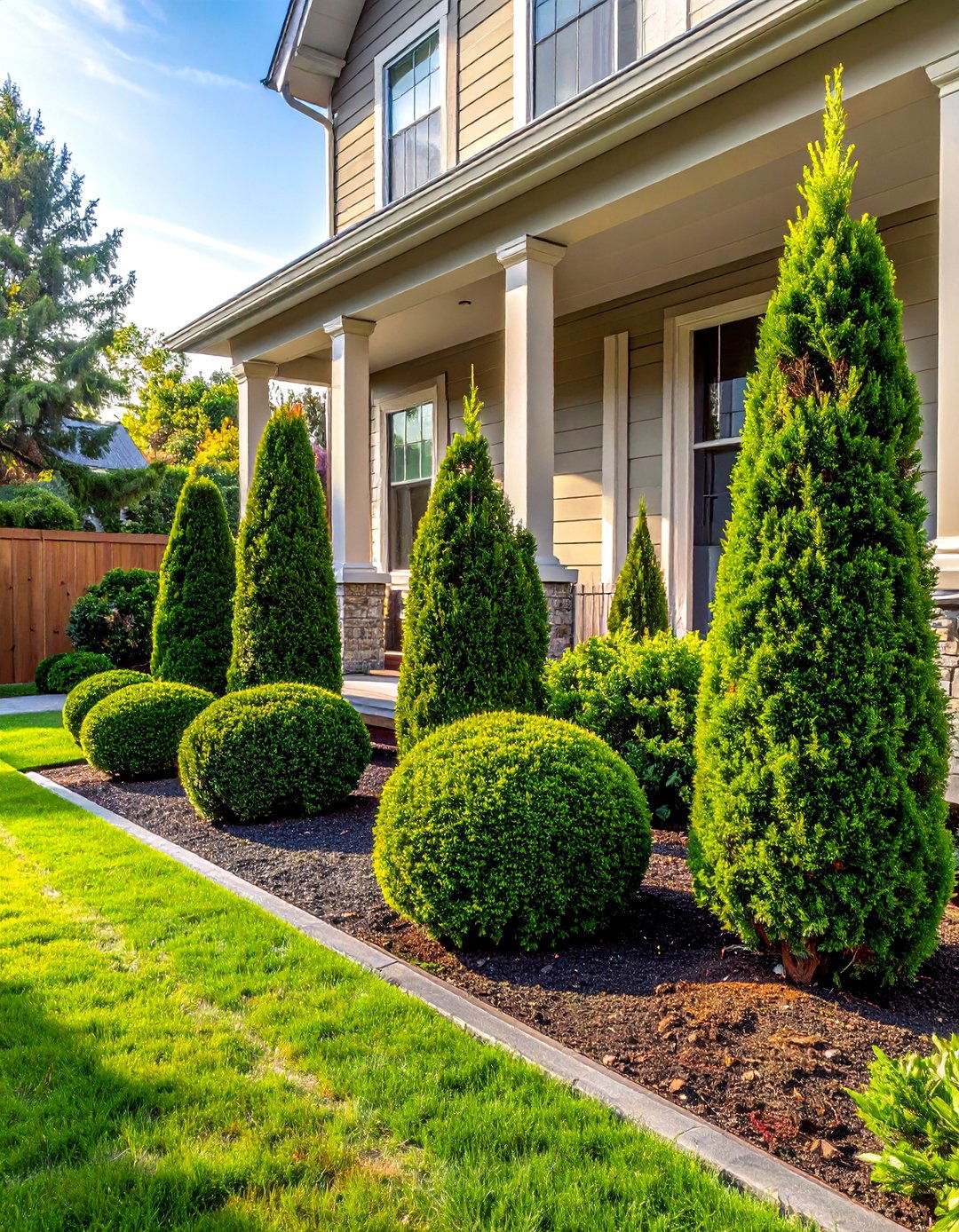
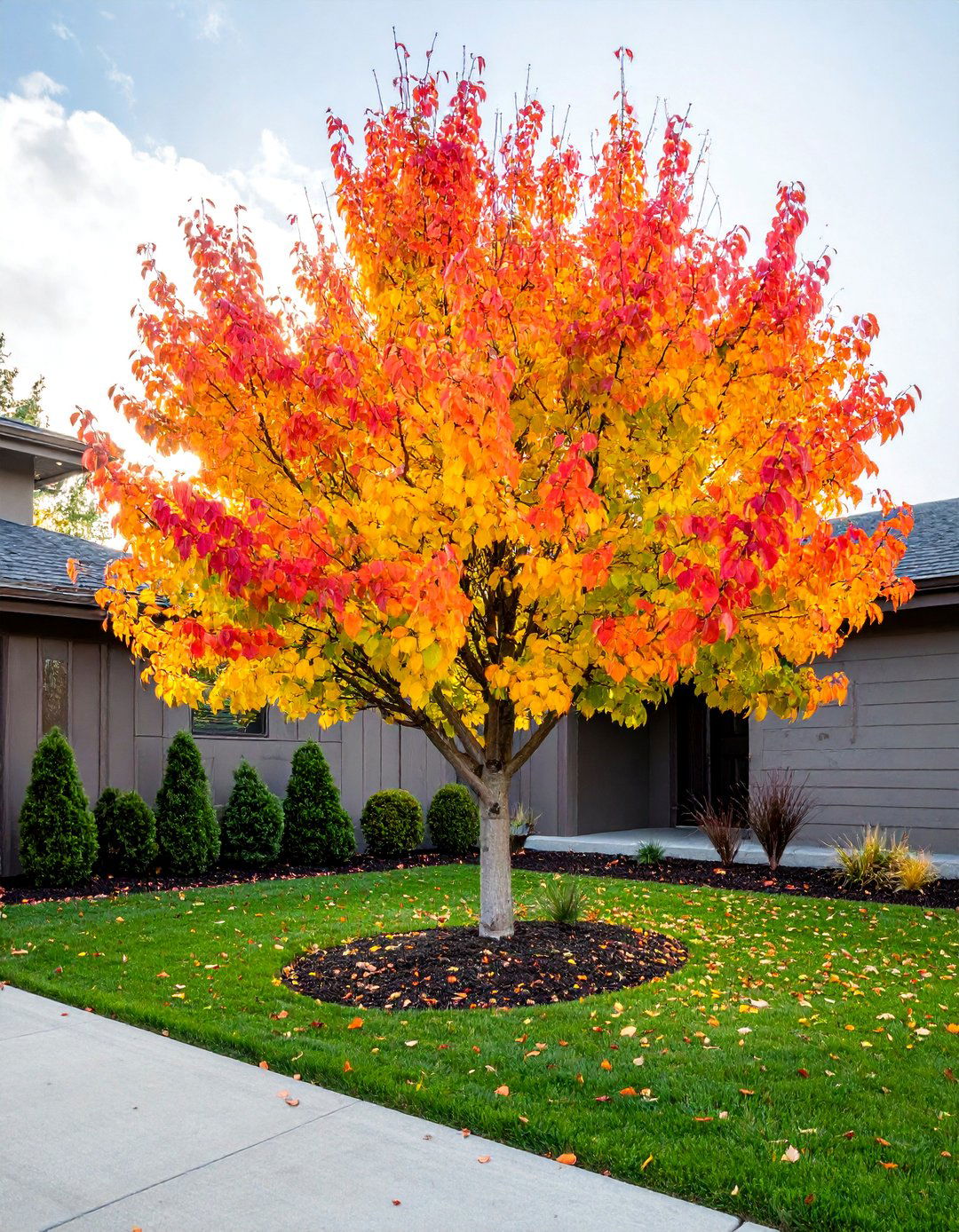
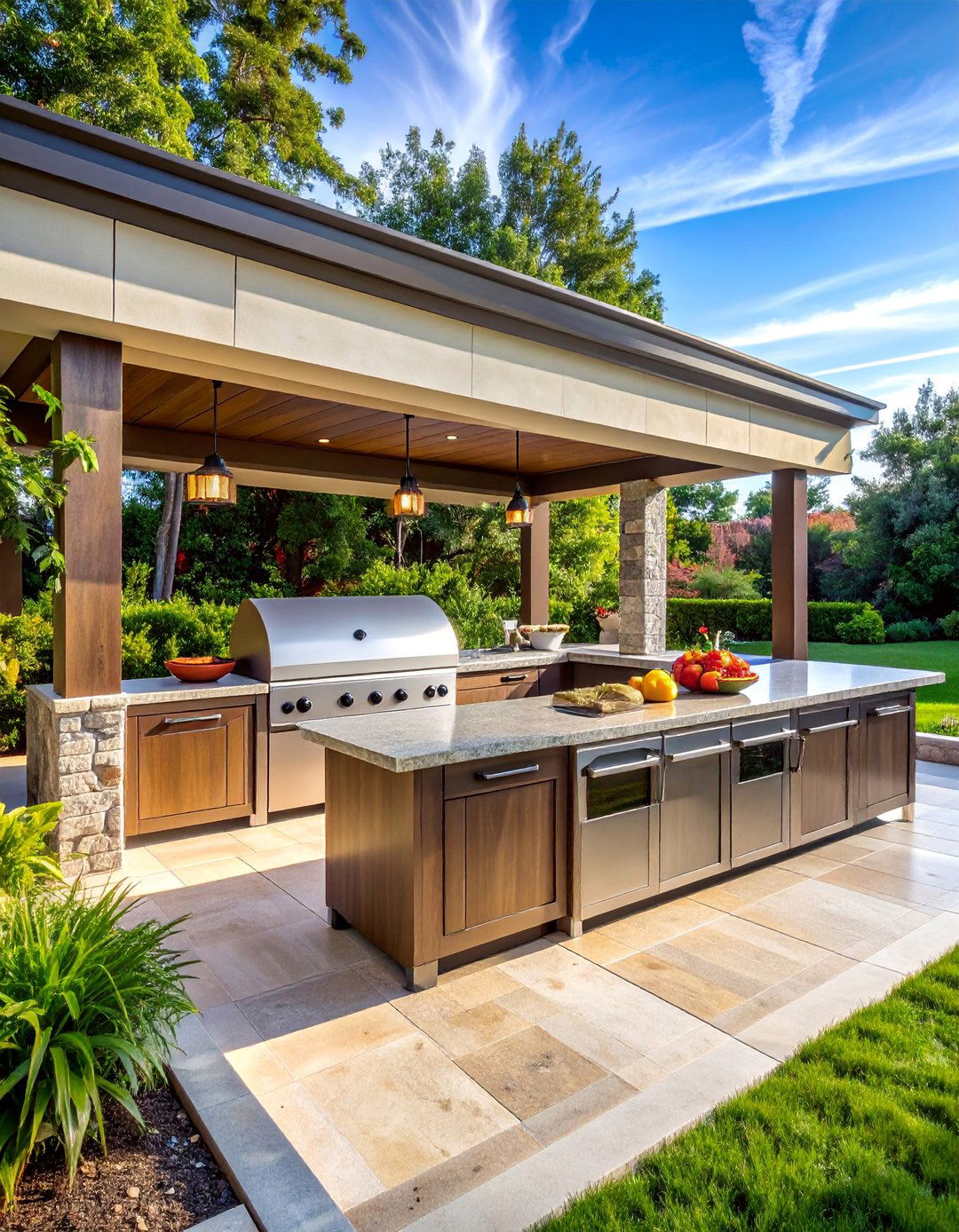
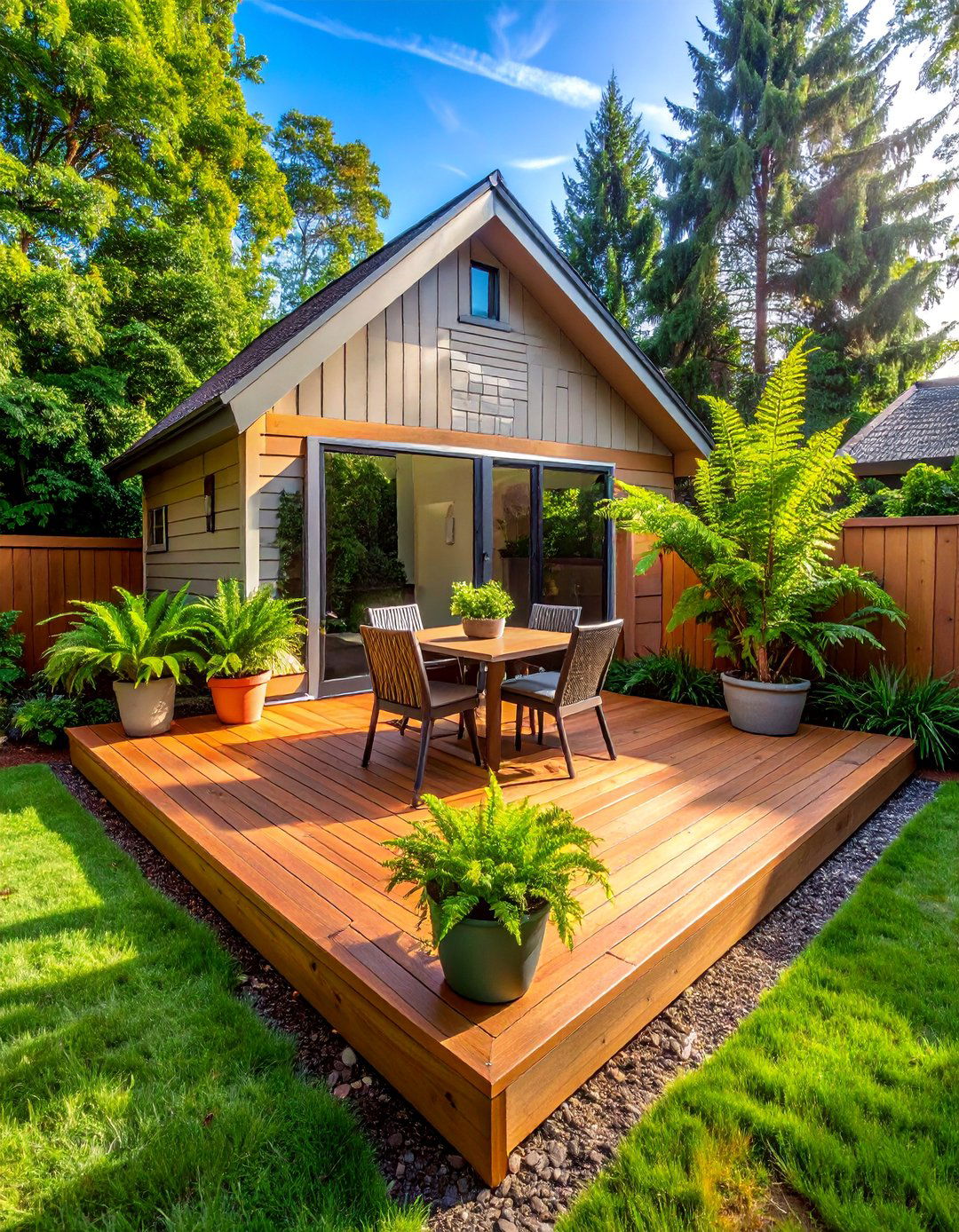
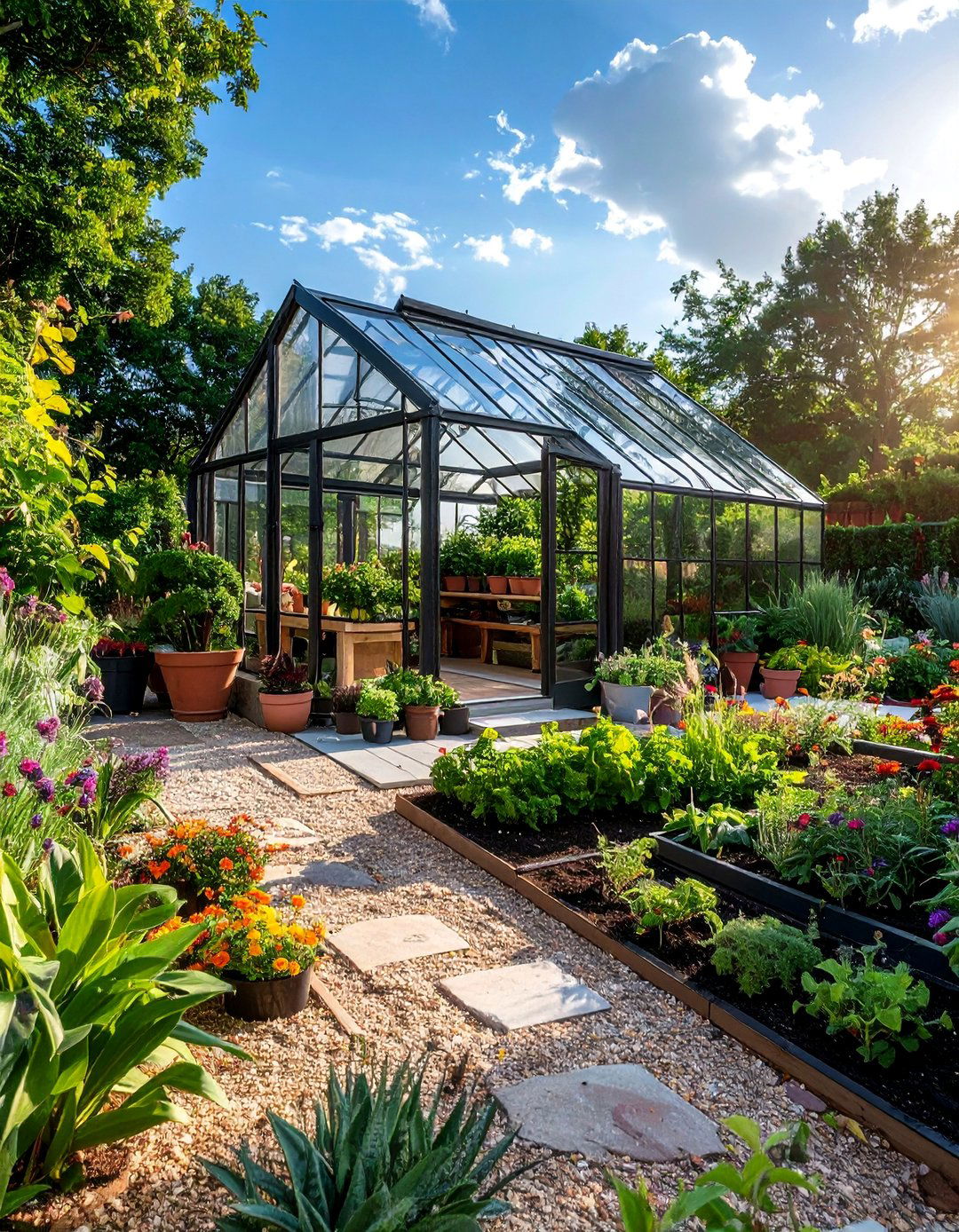
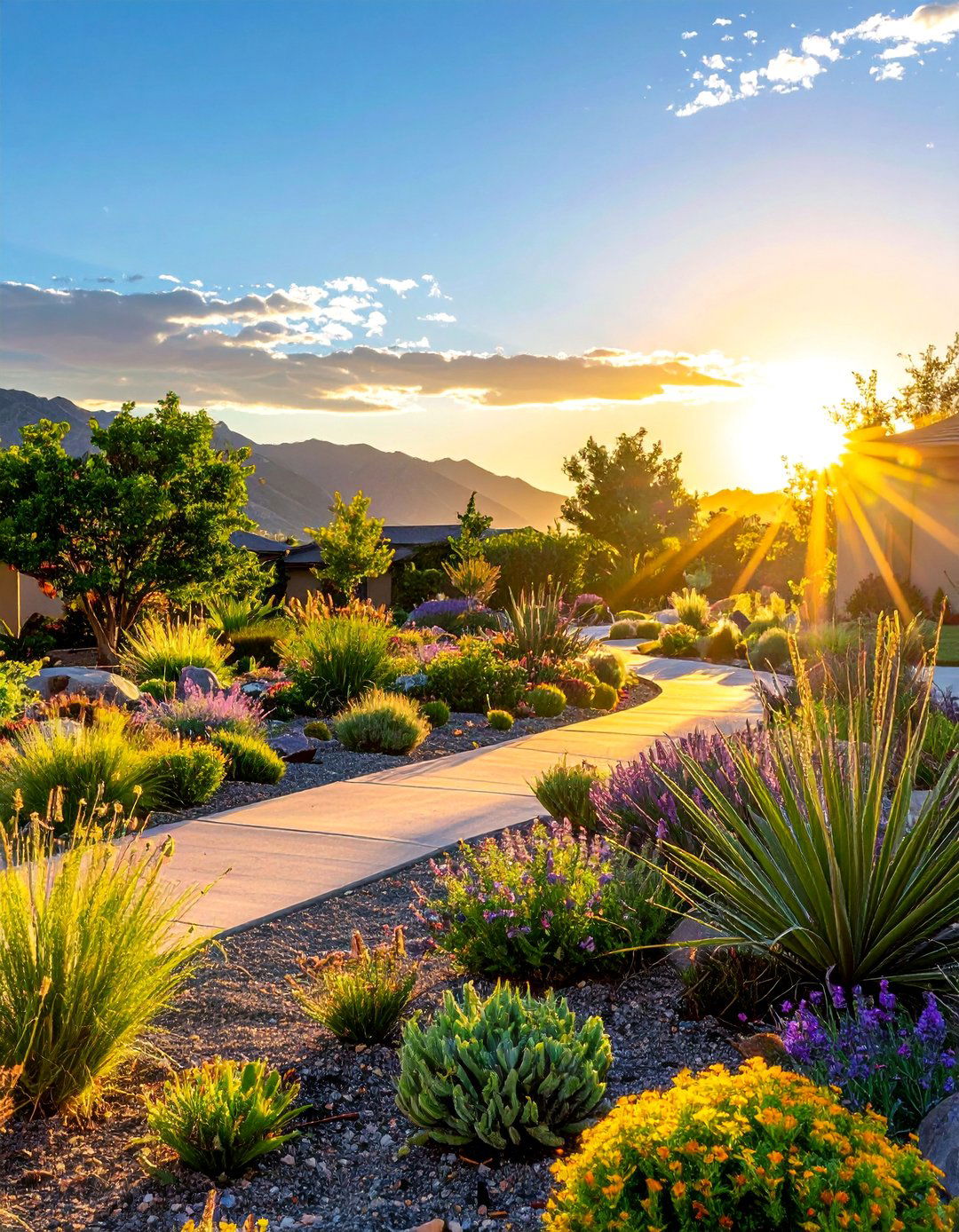
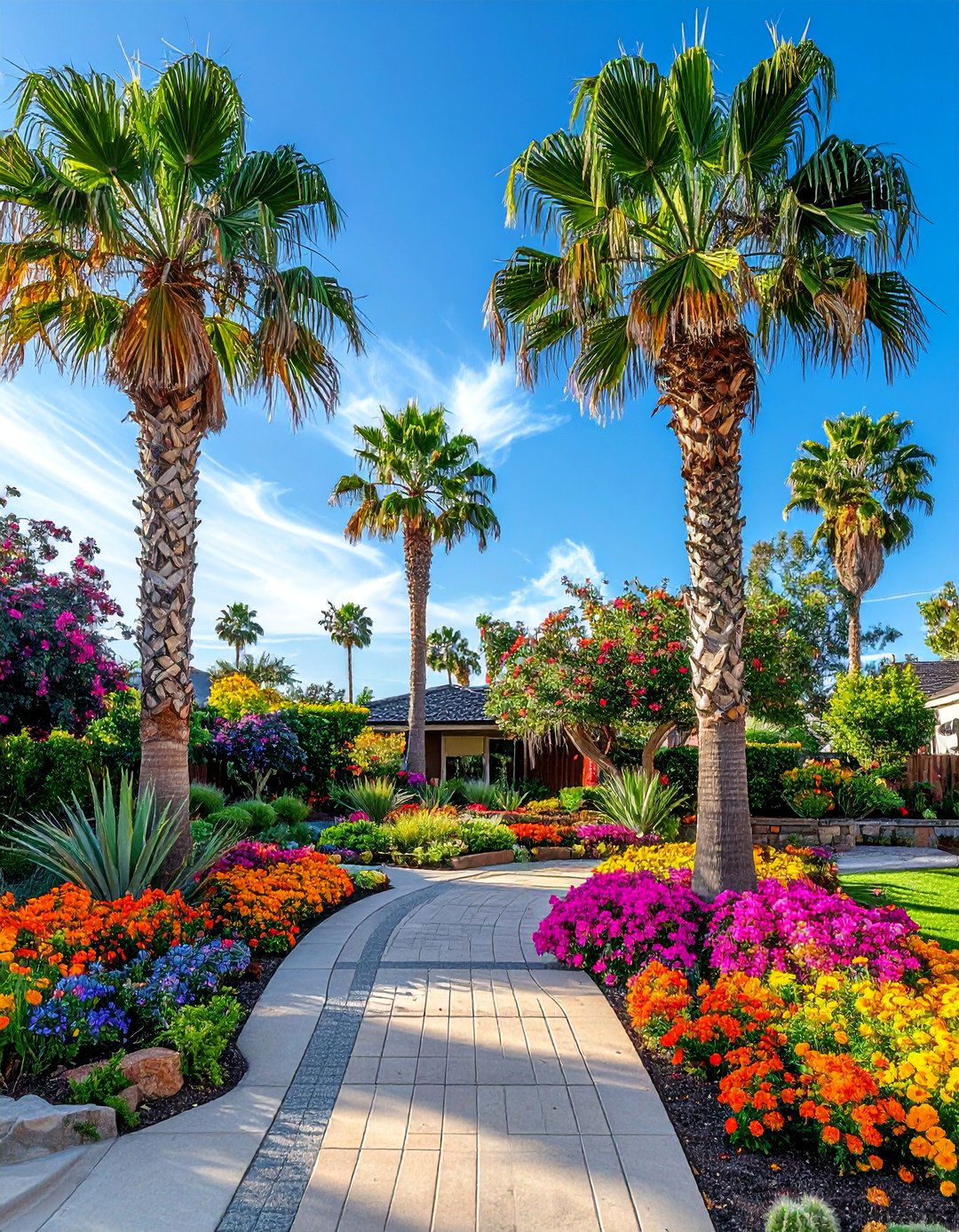
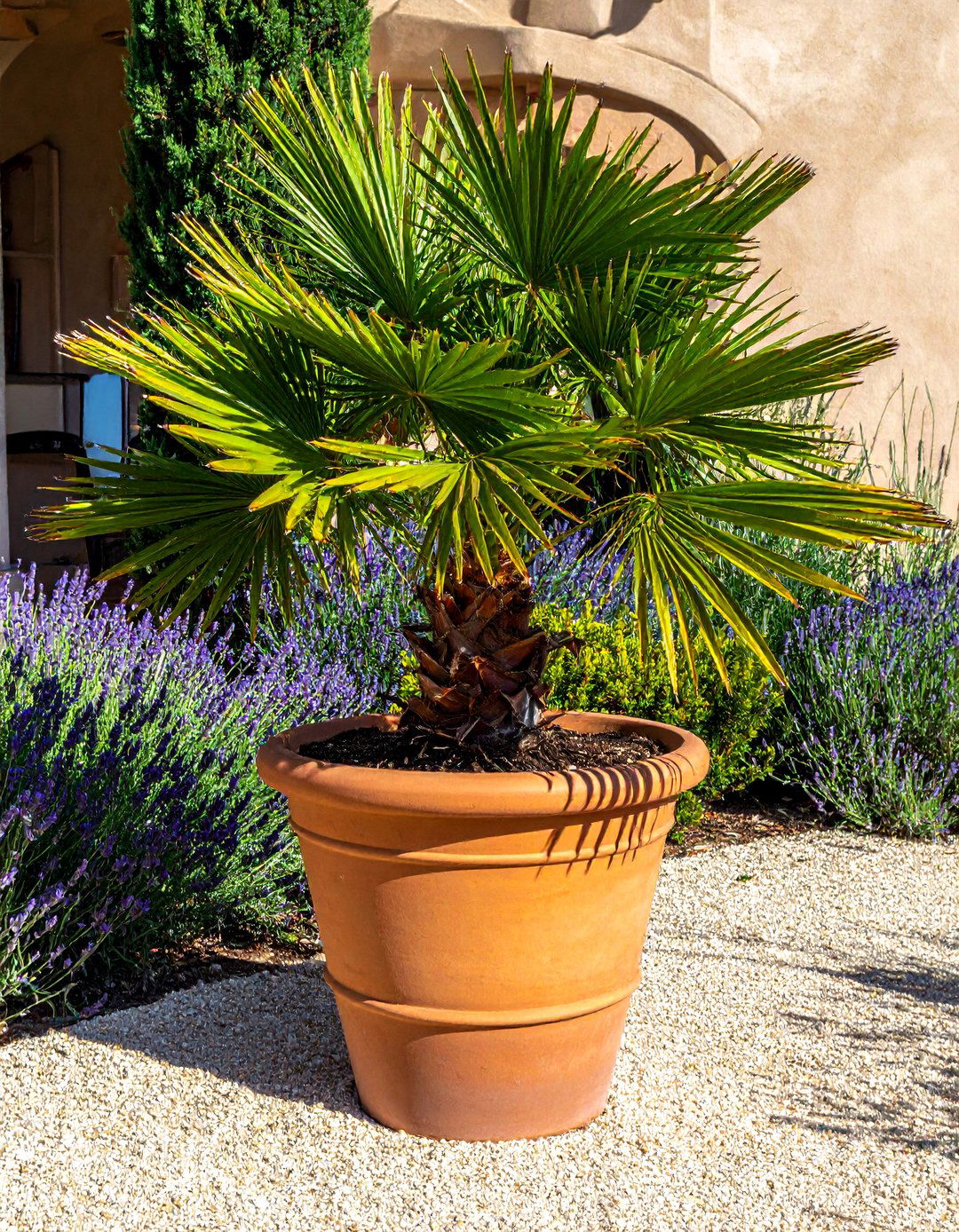
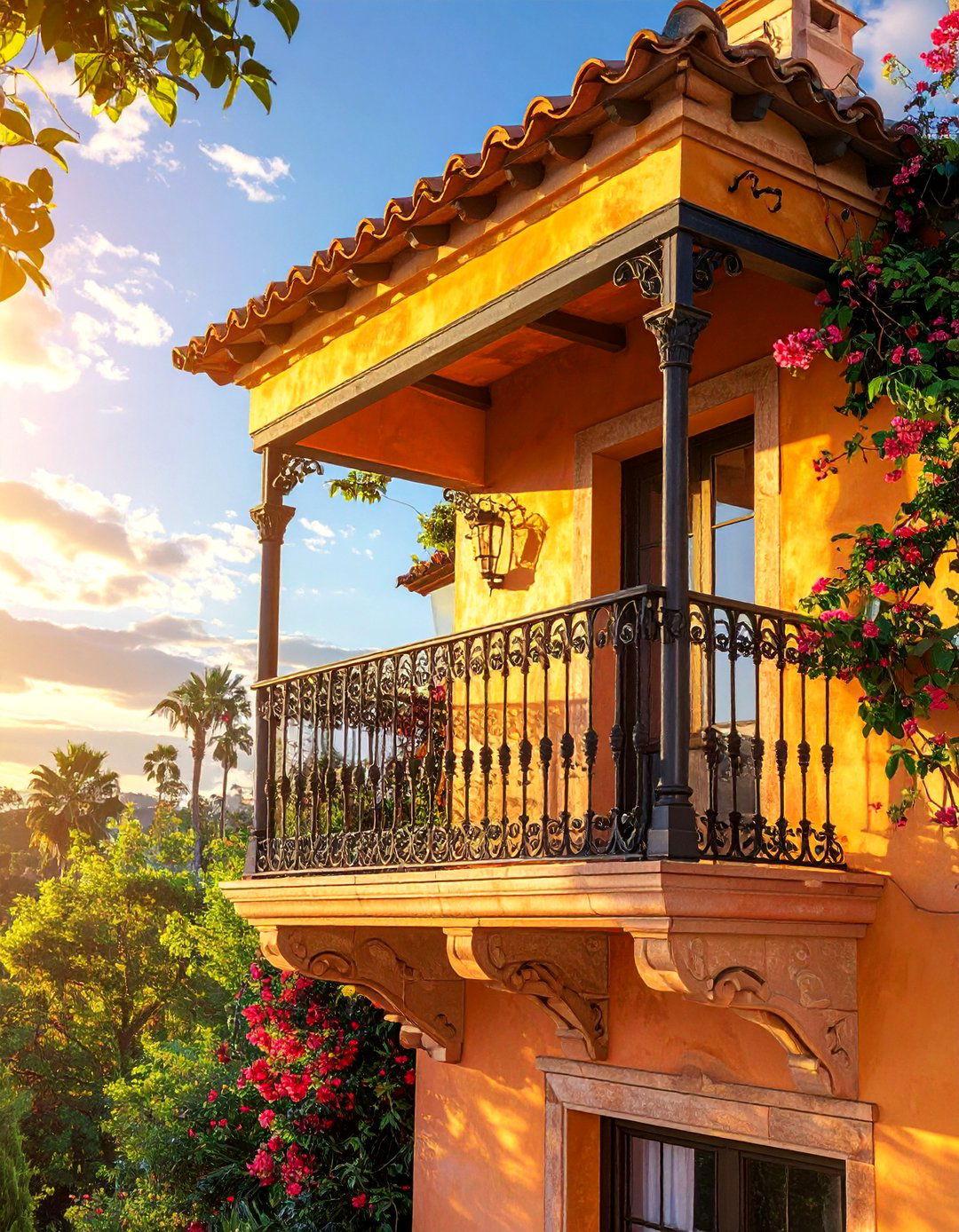
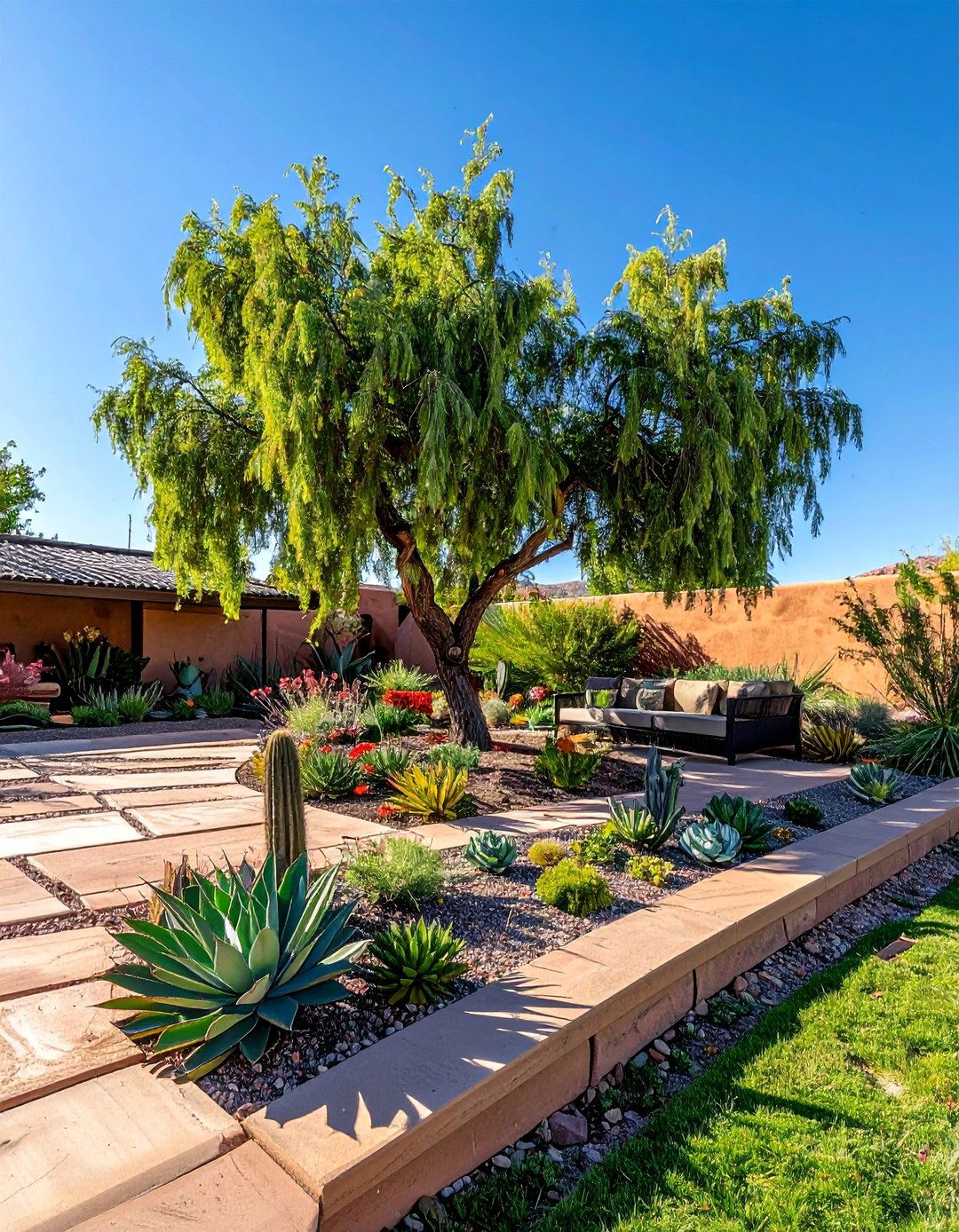
Leave a Reply